Alumni across the decades
1920s-1940s
John Shanly ’23
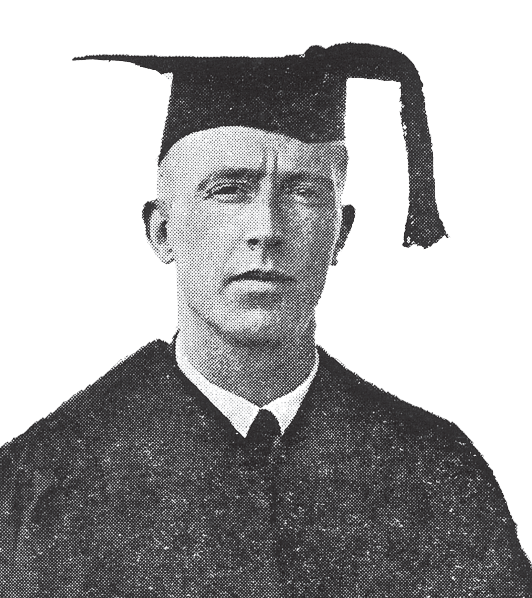
John Shanly.
In 1922, as today, a university degree required roughly four years of study. Yet the Alaska Agricultural College and School of Mines, which opened for classes that year, produced its first graduate — Jack Shanly — the following spring.
Shanly pulled off this feat with help not only from the transfer of his earlier college credits but also, by some accounts, from the fervent advocacy of AACSM’s President Charles Bunnell.
Bunnell first met Shanly as the future graduate filed for a homestead at Fairbanks’ federal land office in summer 1922.
“As they conversed, Bunnell saw in Shanly his first graduating class — and to have a graduate to mark the end of the first year’s operation was highly desirable,” wrote William Cashen in “Farthest North College President,” his biography of Bunnell.
Shanly had studied several years at Cornell University in New York before volunteering to drive ambulances in France during World War I, according to Cashen. When the U.S. entered the war in April 1917, Shanly returned to the U.S. and began flight school in Florida. The war ended before he saw combat.
So he headed west, working as a logger in Oregon and as a laborer on an Alaska Railroad construction crew. He then spent two years mining coal in Healy.
Graduating Shanly from AACSM in 1923 required some pushing and pulling.
“The faculty did everything they could to offer the courses necessary for completion of his degree requirements in one year,” Cashen wrote. “It was nip and tuck in chemistry, but Shanly finally edged safely over the line.”
Chemistry wasn’t the only obstacle. The other was Shanly’s primary professor, according to a 2005 article by Fairbanks Daily News-Miner columnist Dermot Cole ’79.
Jessie Bloom, wife of AACSM Trustee Robert Bloom, recalled that the agriculture professor believed Shanly was “not fit to graduate,” Cole reported.
Jessie Bloom, in writings Cole found at the UAF Rasmuson Library’s Alaska and Polar Regions Collections and Archives, said Bunnell overruled the professor.
Whatever his academic challenges, Shanly was well liked. Fellow students elected him class president. Despite Prohibition, he brewed homemade beer at his homestead cabin, according to firsthand observations from a faculty member — the future UA President Ernest Patty.
After graduation, Shanly worked as principal of the Nenana High School briefly, then left Alaska.
Shanly lost title to his homestead cabins in 1926. Independent Lumber took them because the construction supplies bill remained unpaid, according to a biographical paper written by a New York teacher, Thomas Patton, and cited by Cole.
Though he never lived in Alaska again, Shanly visited and stayed in close contact with his friends here. He married twice and had three daughters.
In 1937, Shanly sold his homestead to Bunnell, who subdivided it. The land underlies much of the community of College.
Shanly produced educational movies for a time and eventually became a federal Food and Drug Administration inspector. In 1956, he launched a second career in Buffalo, New York, as an international travel tour operator. He died in 1971 at age 77 when a car struck him near his home in Cuba Lake, New York, where he had retired.
Shanly’s eldest daughter, Patricia, attended UA in the late 1940s and married Brad Phillips ’50, who became a well-known tour boat operator and state senator from Anchorage. She died in an automobile crash in the 1960s.
In 2004, Shanly’s once-controversial diploma was discovered among items Phillips had in storage in Anchorage. It’s now in the Rasmuson Library’s archives, with a copy hanging in the UAF chancellor’s office.
— Sam Bishop
Genevieve Parker Metcalfe ’28
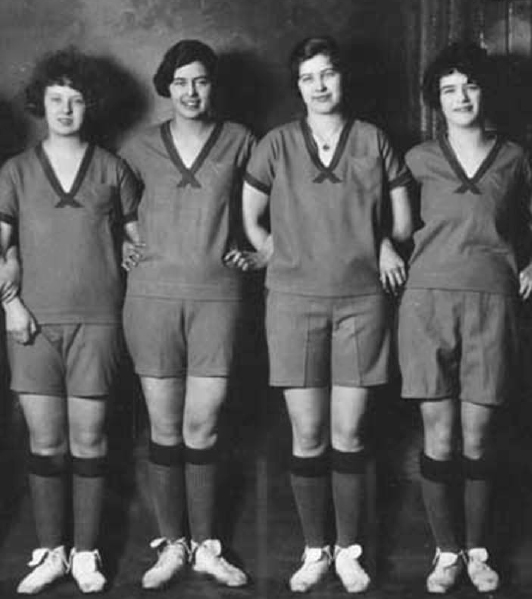
Genevieve Parker Metcalfe, second from left, stands with teammates from a women’s basketball team early in the school’s history.
Genevieve Parker Metcalfe grew up among miners, so in a different era it might not have been surprising that she became a mining engineer herself. But she earned that degree from the Alaska Agricultural College and School of Mines in 1929, and for a time she was celebrated as the sole female mining engineer working in the nation.
Metcalfe’s parents, Fred and Genevieve Parker, married in Fairbanks in 1905, just a few years after it arose as a mining supply camp. When his daughter was 7 years old, Fred Parker left his sawmill business in town and the family moved to a mining claim on Fairbanks Creek.
“Lacking peers, my great interest was the mine,” Metcalfe wrote later. “I ran errands all over the place, taking small tools and messages to outlying areas. Midafternoons, I shouldered a yoke to take around hot coffee or iced tea plus cake, pie or cookies — to the delight of the men working a hard 12-hour shift.” She grew up visiting with some of the men who first discovered gold in the area, including Felix Pedro’s partner Tom Gilmore, for whom Gilmore Dome is named. The world-class Fort Knox Mine today harvests gold from a vast pit on the dome’s northern flank a few miles west of Fairbanks Creek.
I remember one of the lawyers telling
me, ‘Now be sensible. Take a good domestic science course.’”
The Parker family moved back to town in 1921. Metcalfe attended high school and then enrolled at AACSM in 1924, just two years after the institution opened for classes. She edited the Farthest North Collegian school newspaper, ran sled dogs competitively and played on the women’s basketball team.
After earning a science degree in 1928, Metcalfe asked Professor Ernest Patty if she could earn a mining engineering degree. Patty and other professors encouraged her, but the question was debated by the university’s trustees, some of whom doubted that mining companies would employ her.
“I remember one of the lawyers telling me, ‘Now be sensible. Take a good domestic science course,” she told Leslie Noyes, author of a 2001 history of the mining school, “Rock Poker to Pay Dirt.”
Metcalfe declined the advice but still faced obstacles. The Fairbanks Daily News-Miner reported that “the boys of the Mining Society,” a popular fraternity-like club, declined her full membership.
The problem might have been the secret initiation ritual. “Stripped down to their skivvies, initiates relived the Trail of ’98 by being dunked in a tub of ice-cold water (to simulate losing their raft in the waters of Lake Bennett) and drank raw oysters and eggs from an assay crucible,” Noyes wrote.
Nevertheless, Metcalfe went on to write a 64-page thesis, “The Evolution of Placer Mining Methods in Alaska,” that far exceeded the minimum requirements for her degree. For the study, Metcalfe interviewed Gilmore and some of the other early miners she met while growing up.
“Even now, 75 years later, her thesis is considered an important reference on Alaskan placer-mining history,” according to Metcalfe’s biography at the Alaska Mining Hall of Fame website. “Her contribution to the understanding of early placer mining technologies and to the history of the Fairbanks mining district will always be considered primary references for those subjects.”
Like many AACSM graduates, Metcalfe went to work at the Fairbanks Exploration Co. after graduating. In 1930, she left for a job with its parent company, the U.S. Smelting, Refining and Manufacturing Co., in Boston.
“Being a woman mining engineer, Genevieve became a celebrity of the day,” her Hall of Fame biography noted. The Engineering and Mining Journal featured an article on Metcalfe with a photo of her driving a nine-dog team. She even met President Herbert Hoover that year. Metcalfe, writing to Noyes, said she was welcomed into Boston’s professional and academic engineering community. She said some male colleagues lamented that their wives, who had studied alongside them, couldn’t get recognized as engineers.
“Of course it was easier to recognize that sort of thing in Alaska — particularly early Alaska — than in other places,” Metcalfe told Noyes. “It was just assumed in Alaska that a woman could do most anything because the women worked as hard as their husbands.”
Metcalfe resigned to raise a family after marrying John Metcalfe, a fellow engineer at USSRM, in 1934. They had a daughter and a son. Following John’s company career, the family moved to Salt Lake City, Fairbanks, Nome and then, in 1942, Massachusetts again, where they remained. John died in 1970, and Genevieve followed in 1995.
— Sam Bishop
Flora Jane Harper ’35

Flora Harper.
Flora Jane Harper was the granddaughter of one of the most successful pre-Gold Rush traders in the Yukon River country, but her famous ancestor bestowed her with little advantage in life. She grew up poor, part of a large family that fled deadly disease outbreaks while struggling in a society where their mostly Athabascan heritage often was a liability.
Harper overcame these obstacles and more to become the first Alaska Native person to graduate from the University of Alaska. She did so in 1935, decades before racial discrimination fell into disfavor in the nation’s social and legal systems.
Harper’s famous grandfather was Arthur Harper, an Irish trader who arrived in Fort Yukon in 1874. He married Seentahna, a 14-year-old Athabascan girl from the Koyukuk River region. Before separating almost 20 years later, they had eight children, including Sam, Flora Jane’s father.
The couple’s youngest son, Walter Harper, became the first man to stand atop Denali in 1913, a member of the Episcopal Archdeacon Hudson Stuck’s successful climbing team.
Flora Jane was born in Rampart in 1910 to Sam and Louise Harper. The family moved to Nenana seeking protection from the 1918 Spanish flu epidemic.
In Nenana, Sam worked for the railroad, but supporting a six-member family wasn’t easy. When Flora Jane was 10, her father sent her and three siblings to Chemawa, a boarding school for Native Americans in Oregon.
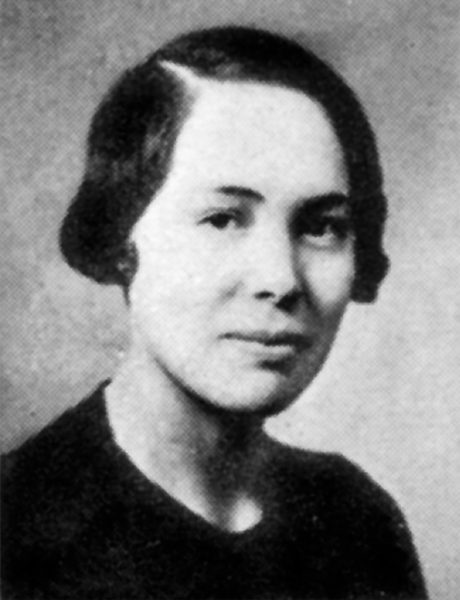
“It’s either that or starve,” he reportedly said.
Flora Jane wasn’t able to return to Alaska for nine years. After graduating from high school in Portland, she contracted tuberculosis and spent almost a year in a hospital.
Once back in Alaska, Harper enrolled at the Alaska Agricultural College and School of Mines. She graduated with a home economics degree in 1935, the year the school became the University of Alaska.
Harper taught at the Bureau of Indian Affairs’ Chilocco boarding school in Oklahoma and its Alaska schools in Wrangell, Sitka and Eklutna. She married Walter “Pete” Petri in Wrangell in 1941. They had a daughter in 1943, and the family moved to Anchorage in 1949.
Jan Harper-Haines ’65, the daughter, wrote about her perceptions, as a child, of her mother’s quiet struggle to maintain her self-esteem in the decades that followed.
“From the time she was a child Mom had sought respect, a desire that propelled her to graduate from the University of Alaska,” Harper-Haines wrote in 2012 on the blog “Growing Up Anchorage.”
Most troubling were the slurs that “smeared all Natives, even my mother, who didn’t drink,” Harper-Haines wrote. “‘People don’t see me,’ she’d say, resigned as she shelved books in the Loussac Library where she worked. ‘They see a drunken Indian on Fourth Avenue.’”
The desire for respect made Harper uncomfortable with her husband’s occasional, strongly worded letters to the editor and prompted her to “damn well make sure we looked presentable.”
“She felt it was her responsibility to help improve the image of Native people. She knew others were watching. She was right,” Harper-Haines wrote.
After retirement, the couple moved to Sequim, Washington. Pete died in 1990, and Flora Jane died in 1992. In 1994, the University of Alaska Fairbanks named the Harper Building on Geist Road after her. The building houses UAF’s Interior Alaska Campus.
Athabascan elder Poldine Carlo, of Fairbanks, recalled being taught by Harper when she was in high school and how it made her feel at the time.
“[She] was the first Native person to graduate from the university, and she was my home ec teacher in Eklutna,” Carlo said at a 2015 event at Troth Yeddha’ Park on the Fairbanks campus. “I was so proud of her.”
— Sam Bishop
Earl Beistline ’39, ’69 (Hon.)
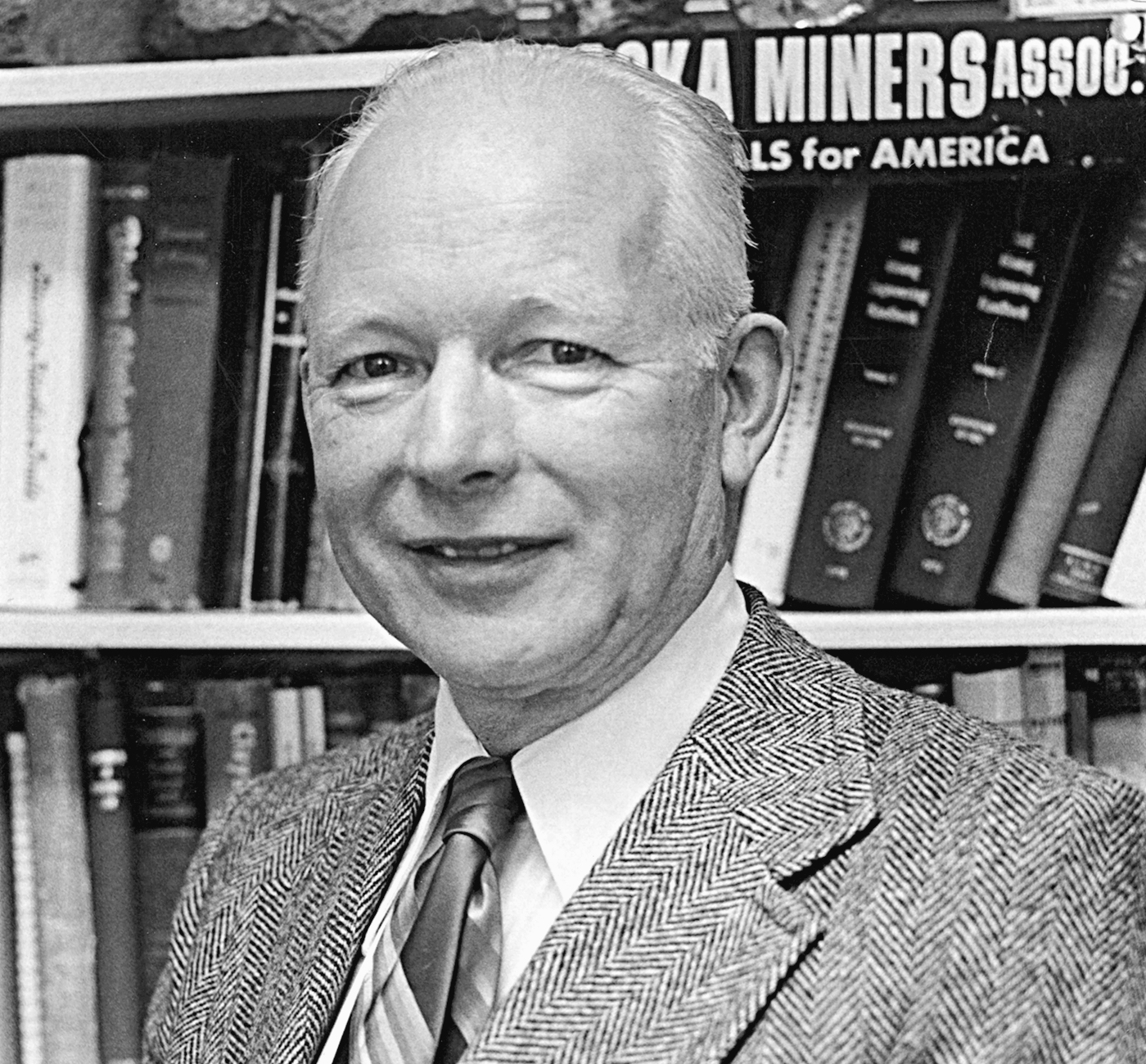
Earl Beistline.
Earl Beistline, one of UAF’s most respected and longest-tenured teachers, might never have entered the profession had it not been for the sensational exit of his predecessor.
A “veritable drama of love, law and politics” opened a teaching job for Beistline, according to Leslie Noyes, author of “Rock Poker to Pay Dirt: The History of Alaska’s School of Mines and its Successors.”
Beistline’s predecessor married the school’s nurse in January 1946, and displeased administrators asked her to resign. If she was forced out, her new husband said, he would quit, too. The dispute went all the way to the Legislature, but the couple lost and left the university.
Suddenly, midsemester, the school needed an instructor to complete classes. The dean called Beistline, an alumnus who had recently returned to Fairbanks after serving in World War II.
“Thus began his 36-year career as an educator with the university. He loved to teach,” his family reported in Beistline’s 2012 obituary.
A former student once described Beistline as possessing a “hurry-up but happy, no-nonsense style.” That style, conveyed by his ever-present smile and energetic pace, made Beistline a popular leader not only at the university but also in Alaska’s mining industry for decades.
Beistline was born in Juneau in 1916, the son of a miner who spent several years in the Fairbanks area before going to work for the Alaska Juneau Gold Mining Co. in Juneau. During the Great Depression, Beistline saw how mining buffered the territory against the economic ravages elsewhere, and he became a lifelong advocate for the industry.
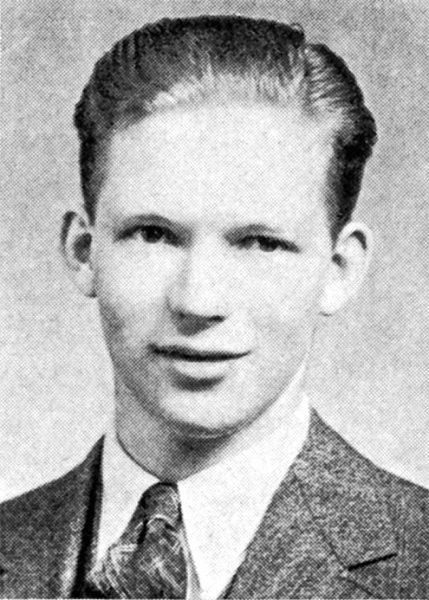
In college, Beistline played hockey, managed the basketball team and was elected student body president. During summers, he drove cold-water points to thaw ground for the Fairbanks Exploration Co. dredges.
Beistline served in the Aleutian Islands during World War II. After returning to the university as an instructor, he earned his professional engineer degree with a thesis on an innovative sampling technique he developed for a company dredging a Salcha River tributary.
Beistline married Dorothy Hering of Fairbanks, and they eventually had four children: Ralph, Bill, Kathy and Linda. (Dorothy later owned and ran Daisy A Day flower shop, and an endowment in her memory helps maintain the Georgeson Botanical Garden.)
University administrators steadily promoted Beistline, first to dean of the School of Mines in 1949, then to dean of faculty in 1960. He became provost in 1970 and later served as academic vice president for the statewide system.
Beistline helped create the Mineral Industry Research Laboratory in 1965. Despite his influence, in the early 1970s he lost a contentious bid to retain the geology department in the mining program.
While a strong advocate for his own views, Beistline always remained a gentleman. He convinced UA President William Wood ’89 (Hon.) to allow a Vietnam War protest on campus, then attended it even though he disagreed with the demonstrators.
After retiring from the university in 1982, Beistline consulted for the industry and operated a placer mine on Eagle Creek with Doug Colp.
In 1986, Beistline helped form the Alaska Minerals Commission to advise the state on mining policy. As chair, he lobbied legislators on issues important to the industry in Alaska.
With Wood, Beistline helped create the Alaska Mining Hall of Fame in 1997 and was inducted a decade later. In 2006, he became one of the few Alaskans accepted into the National Mining Hall of Fame.
When Beistline died in 2012, a Fairbanks Daily News-Miner editorial said he had “left a legacy of service to Alaska that has been matched by few people in our state.”
— Sam Bishop
Ray Smith ’43

Ray Smith.
Ray Smith never expected to attend college. In his small Maine hometown, those who did so were viewed as “kind of peculiar.” So in August 1939, when he and his friend Lloyd Atwood hiked the railroad tracks from Fairbanks to the University of Alaska, it was to find a job, not an education. The pair of 22-year-olds were out of money and hungry, having just arrived from the East Coast.
Reaching campus in late afternoon, Smith and Atwood found a man digging a ditch on the northwest corner of the Main Building. The man said he didn’t think there were any jobs around; he was just happy to have one himself. But he added that they could get a meal at a nearby house.
After a brief debate won by their growling stomachs, the pair knocked on the door, Smith told Leslie Noyes, author “Rock Poker to Pay Dirt,” a history of UAF’s mining school published in 2001.
A woman invited them in and said “President Bunnell” would join them shortly.
“A moment later, out pops this rotund guy all dressed up in a suit, and it was our ditch digger, President Charles Bunnell!” Smith said.
Over dinner, Bunnell asked the pair to enroll. Smith and Atwood said they had no jobs, money or place to stay. Bunnell offered them an old cabin near campus in exchange for repairs and noted that tuition was free. There was no refusing the man.
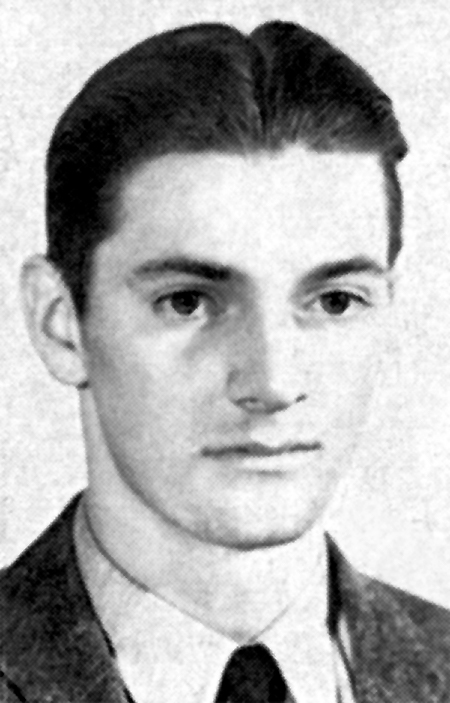
“He changed my life in the couple of hours I first met him,” Smith said last year, shortly before turning 100. “He remains a hero in my book of memories. I went from a broken upstart to a university president with his boost.”
But that’s getting ahead of the story. First, Smith and Atwood had to survive the winter. They built an outhouse and root cellar, cut firewood and chinked the leaky cabin. They snared hares, picked berries and shot grouse, ducks and caribou. They recruited another roommate — Ernie Wolff ’41— who some years later would join the university faculty and run its Mineral Industry Research Laboratory.
After graduating in 1943, Smith served in the Army during World War II and married Beatrice Bennet in Maryland. They eventually had two sons. After the war, they returned to Alaska, where Smith began teaching at the School of Mines.
One highlight, he recalled, was preparing students for a final exam. “My method of teaching was to teach my students to think ‘why,’” Smith said.
In contrast, a fellow professor pushed memorization.
“At the conclusion of the final exam, my students were far superior,” Smith said. “I was proud of them.”
After three years, Smith left to earn a doctorate. In 1959, Michigan Technological University hired him to teach, and in 1965 he became its president.
In that role, he employed the personal touch he saw Bunnell model decades earlier.
Paul Metz ’75, now a UAF professor, was a geological engineering student at Michigan Tech when Smith became its president. Metz left a message inviting Smith to dinner at an old boarding house where Metz and about 20 other students lived.
To Metz’s surprise, Smith accepted. “So he came over and chatted and stayed til late at night” telling stories of Alaska, Metz recalled.
Ten years later, Metz was studying under Ernie Wolff for his master’s at UAF. On a trip to Michigan, Metz visited Smith again, this time at Wolff’s insistence. “We sat all night long chatting about the university,” Metz recalled.
Smith served as Michigan Tech’s president until 1979, overseeing a great expansion.
Smith’s first wife, Beatrice, died in 1998. He married Rachel Malcolm three years later. They live in Green Valley, a retirement community in southern Arizona.
— Sam Bishop
Jane MacKinnon ’47
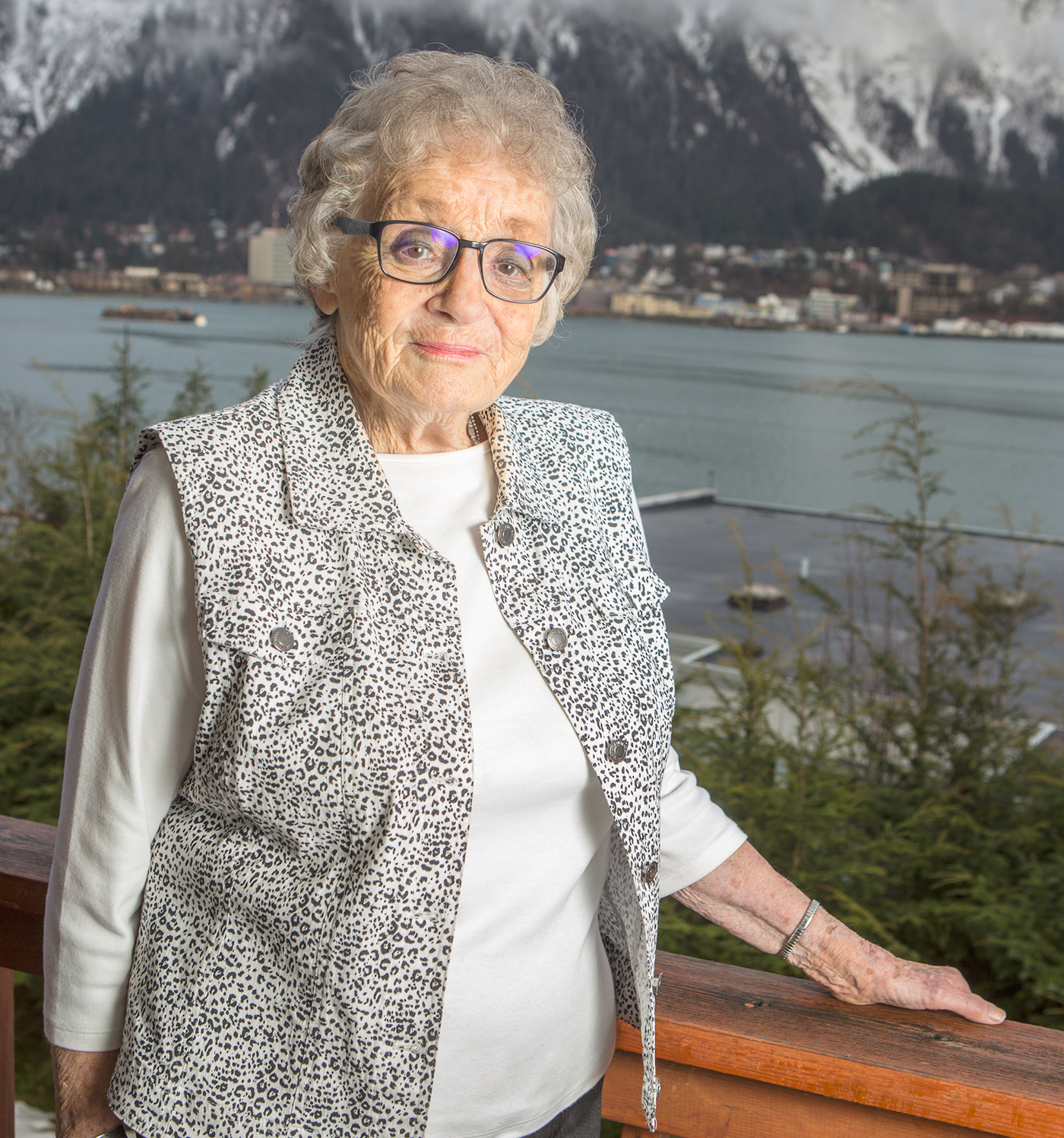
Jane MacKinnon.
Jane MacKinnon remembers precisely how many students studied at the University of Alaska when she started school in the mid-1940s. That’s because she knew all 33 of them.
The Fairbanks campus, depleted by student enlistments during World War II, was a tightknit community for those who remained. Every student lived in a single dormitory, along with some of the teachers. They were joined on campus by visiting soldiers, since Hess Hall served as an Army hospital during the war.
“There was a closeness,” said MacKinnon, who graduated in 1947 with a degree in business administration. “There weren’t many of us on campus, but we were all good friends. You were acquainted with everybody, even the professors.”
The campus was small enough that some classes consisted of a student meeting individually with a professor. Some of their names — Bunnell, Duckering, Schaible and Skarland among them — are on the sides of campus buildings today.
But MacKinnon, 93, said the cozy atmosphere suited her well. She’d graduated from Nome High School, where her father owned a flying service, and enjoyed small-town life there after her family moved from Seattle. After spending the year after high school in Anchorage, MacKinnon felt the urge to attend school, and she wanted to remain in Alaska.
“I decided I had to do something with myself,” she said.
MacKinnon said the cost of college was $125 per semester, including room and board. For entertainment the small group would hold dances or ski to a nearby farm to have dinner with anthropology Professor Ivar Skarland. USO tours would occasionally pass through as well, including one headlined by Bob Hope.
Those years left a lasting impression, both personally and professionally.
In Fairbanks, Jane met her future husband, J.S. “Skip” MacKinnon Jr., who was also attending college. Jane and Skip moved to his hometown of Juneau, where she used her business degree to work in the office at Alaska Laundry and Dry Cleaners. The business has been operated by the MacKinnon family in Juneau since the late 1800s.
“I got a good education, and I’ve used it all my life,” she said. “It was a wonderful time.”
MacKinnon maintained her university ties by serving as a board member of the UAF Alumni Association in the 1990s. Jane and Skip were followed at UAF by their son, E. Neil MacKinnon, who earned a mining engineering degree. A great-grandson, Mason Smith, plans to attend UAF in the fall.
Neil described the feel on campus as “different but the same” between his mother’s era in the 1940s and his graduation in 1972. But by the time Jane returned to Fairbanks during her Alumni Association years, she said the transformation was remarkable.
In a half-century, the sleepy campus where everyone knew each other had grown into a hub for education and research.
“I think it’s wonderful. It’s really improved,” she said. “The buildings and the whole atmosphere of the place have just changed so much.”
— Jeff Richardson
1950s-1970s
Neil Davis ’55, ’61

Neil Davis.
T. Neil Davis rebuilt aircraft engines at age 16, conjured a rocket range from scrap at 36 and wrote erudite yet amusing books on wildly diverse topics until his death at 84 last year.
An incident in his book “Rockets Over Alaska” might best illustrate the UAF professor’s unconventional genius.
At NASA’s Goddard Space Flight Center in the early 1960s, Davis planned to send sensors into the upper atmosphere using rockets launched from a ship. Before the sensors went on the rockets, NASA’s test facility had to spin them to make sure they’d survive the launch. But a more prestigious satellite project knocked Davis’ sensors off the test schedule just before the ship was to sail.
Instead of giving up, Davis and his crew hung a sensor from a tree with two ropes, walked it in circles until it was wound up tight and then released it, letting the sensor spin rapidly. The testing facility picked up the signals and confirmed the sensor had spun fast enough to meet the launch criteria. The sensors and their rockets got on the ship.
So did Davis, and he spent the next month sailing the southern seas and launching his devices into the ionosphere.
That work and other projects provided the technical expertise and contacts that helped him establish the Poker Flat Research Range just north of Fairbanks a few years later.
The U.S. military was looking for a northern range in 1968 because Denmark had nixed several experiments in Greenland after a U.S. B-52 carrying nuclear bombs crashed there.
The military contracted with UAF’s Geophysical Institute, even though it had no rocket range. So Davis, by then the institute’s assistant director, and about half the institute’s staff built one in a hurry, and the first rocket launched in March 1969.
Davis developed that ability to make do early on, as his parents moved across a Depression-strangled America looking for work.
“It was very difficult,” he said in late November 2016 while sitting at the home he and his family built on Miller Hill Road, just west of campus. “We were pretty poor, actually.”
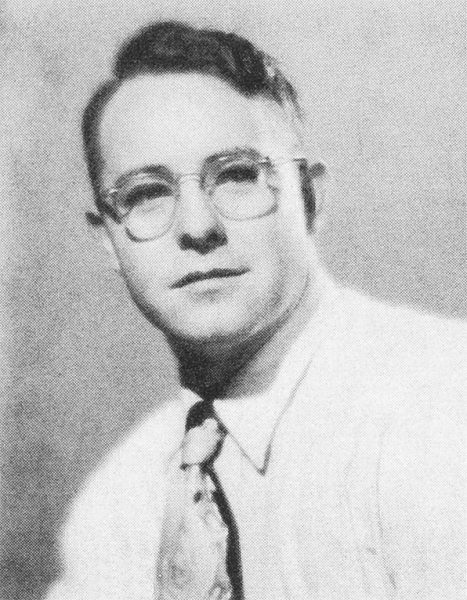
In 1942, Davis’ parents moved to Alaska when his father got work with the military. Davis and his younger brother followed two years later after their parents homesteaded southeast of Fairbanks.
Far from town, Davis took correspondence courses for school. “Somehow school was not right — the only course I finished was one on gasoline engines,” he said.
In 1947, Wien Airlines hired him as an intern mechanic. Within a year, at age 16, he was rebuilding the big radial engines in DC-3 aircraft.
He finished high school in Iowa. There, he met his future wife, Rosemarie. From 1953 to 1962, they had three children: Patricia, Douglas and Deborah.
Davis earned his bachelor’s in geophysics from UA in 1955, a master’s from the California Institute of Technology in 1957 and a doctorate from UA in 1961.
Davis took an early retirement from UAF in 1981. As grant money for scientific work tightened, he had begun to find the job frustrating. The state’s enticing retirement rules at the time tipped his decision.
“I still feel guilty about doing that,” he said in November. “I figured I still owed it to the Alaska public to do what I can.”
What he could do was write. He’d found the talent when he started a weekly newspaper
column about Alaska science
in 1976.
So Davis became an author, completing a dozen books. He explained permafrost in one and the aurora borealis in another. He chronicled the University of Alaska’s early decades. He told the story of his experience with the health care system as daughter Patricia died of cancer.
The books never made money, he said.
They were his gift to Alaska, a generous return on that early retirement.
— Sam Bishop
Editor’s note: Neil Davis died at his home Dec. 10, 2016, just 10 days after he was interviewed and photographed for this article.
Ann Tremarello ’57
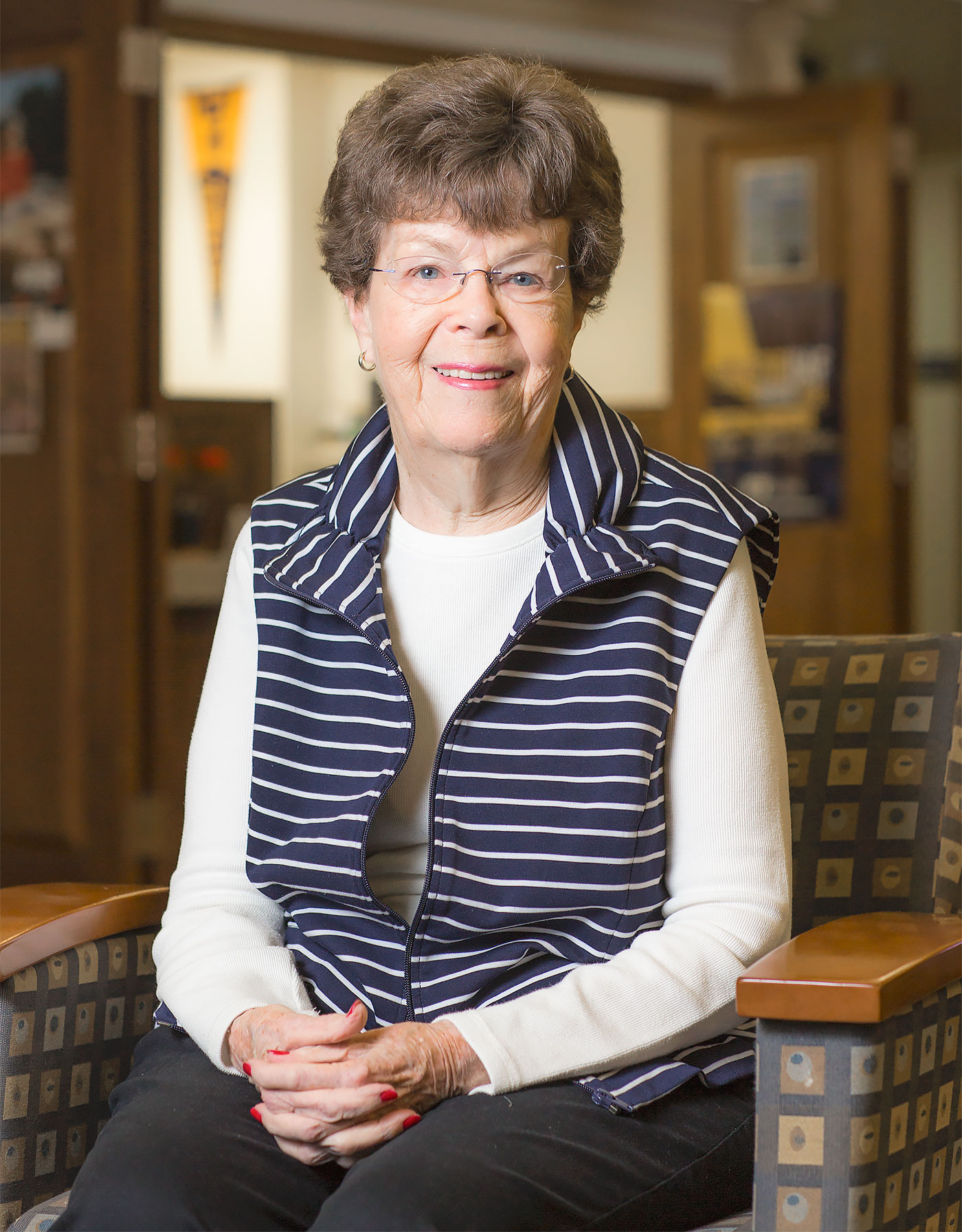
Ann Tremarello.
Ann Tremarello arrived at the University of Alaska with a simple goal: Put in her time and go somewhere else.
Her family was planning to move in 1953 from Virginia to Elmendorf Air Force Base, near Anchorage, where her father was being stationed. He wanted his daughter, who had just graduated from high school, to stick close to home.
“He felt I was too young to live that far away,” she said. “He said, ‘There’s a college up there somewhere. Go there for a year.’”
Tremarello’s plan to make a quick exit from Alaska failed, but there isn’t a hint of regret in her voice. She not only graduated from the University of Alaska, she also played a crucial role in welcoming new students to Fairbanks in the decades that followed.
She retired in 2002 after a long career as the registrar. During her tenure at UAF, Tremarello watched as the campus grew from a remote outpost to a modern university.
When Tremarello enrolled at UA, that journey seemed unlikely.
She stepped onto a tiny campus with 400 students — just one-fifth the size of her Virginia high school. Since it didn’t offer her preferred degree of interior design, she took shorthand and typing, figuring she’d eventually “get a job and go somewhere else.”
But after a year, she told her father that she’d try another. When she met her future husband, Joe Tremarello ’56, ’68, as a sophomore, suddenly Fairbanks seemed like a good place to stay.
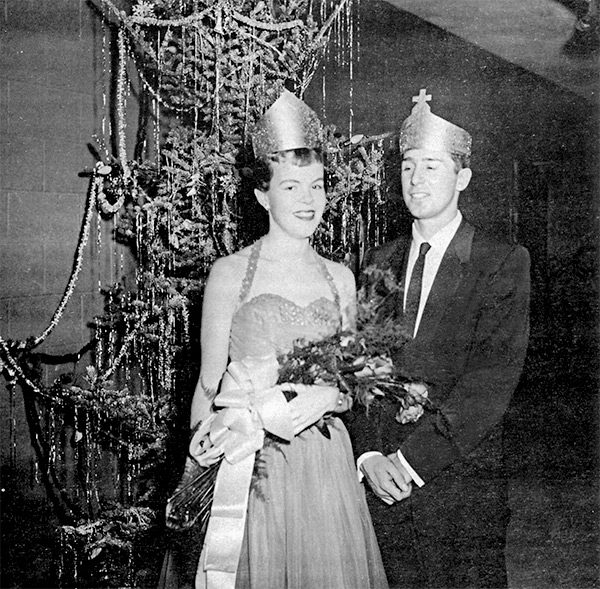
“After that, all thoughts of leaving left my mind,” she said.
Tremarello said the campus was “rough by today’s standards,” with few buildings and limited class offerings, but the colorful, close atmosphere drew her in. An eclectic blend of students and instructors knew each other and would often socialize. The school’s president, Ernest Patty ’53 (Hon.), even policed the punch bowl during dances to keep students from spiking it with booze.
Those ties continued after she graduated in 1957 with a business administration degree. After briefly working for an accounting firm in downtown Fairbanks, the newly married Tremarello decided she wanted to work closer to their on-campus apartment.
The registrar, Laura Jones, offered Tremarello a job, where she was one of three “worker bees” who did it all — churning out transcripts, recording grades and processing scholarships.
She would also do dictation for Jones, who answered all queries personally and sent new students a list of college supplies. Years later, Tremarello learned she had been telling students to bring their goulashes to campus, using the spelling for the Hungarian comfort food rather than the wet-weather footwear.
“I was horrified when I found out, but the university survived in spite of me,” she said with a laugh.
Tremarello remained in the office for the rest of her long career, ultimately seeing her once-tiny campus grow to 9,000 students. By the time she retired, Tremarello had overseen the evolution from a manual filing system to the computer age, with a few other record-keeping overhauls in between.
Her best memories, however, were about helping students make the sometimes-difficult transition to college. By the time she left UAF, Tremarello had the moniker of a favorite aunt — Ann T.
“I loved working with students — that was probably the best part of my job,” she said. “It was the way I felt we could help.”
— Jeff Richardson
Linda Gordon ’65
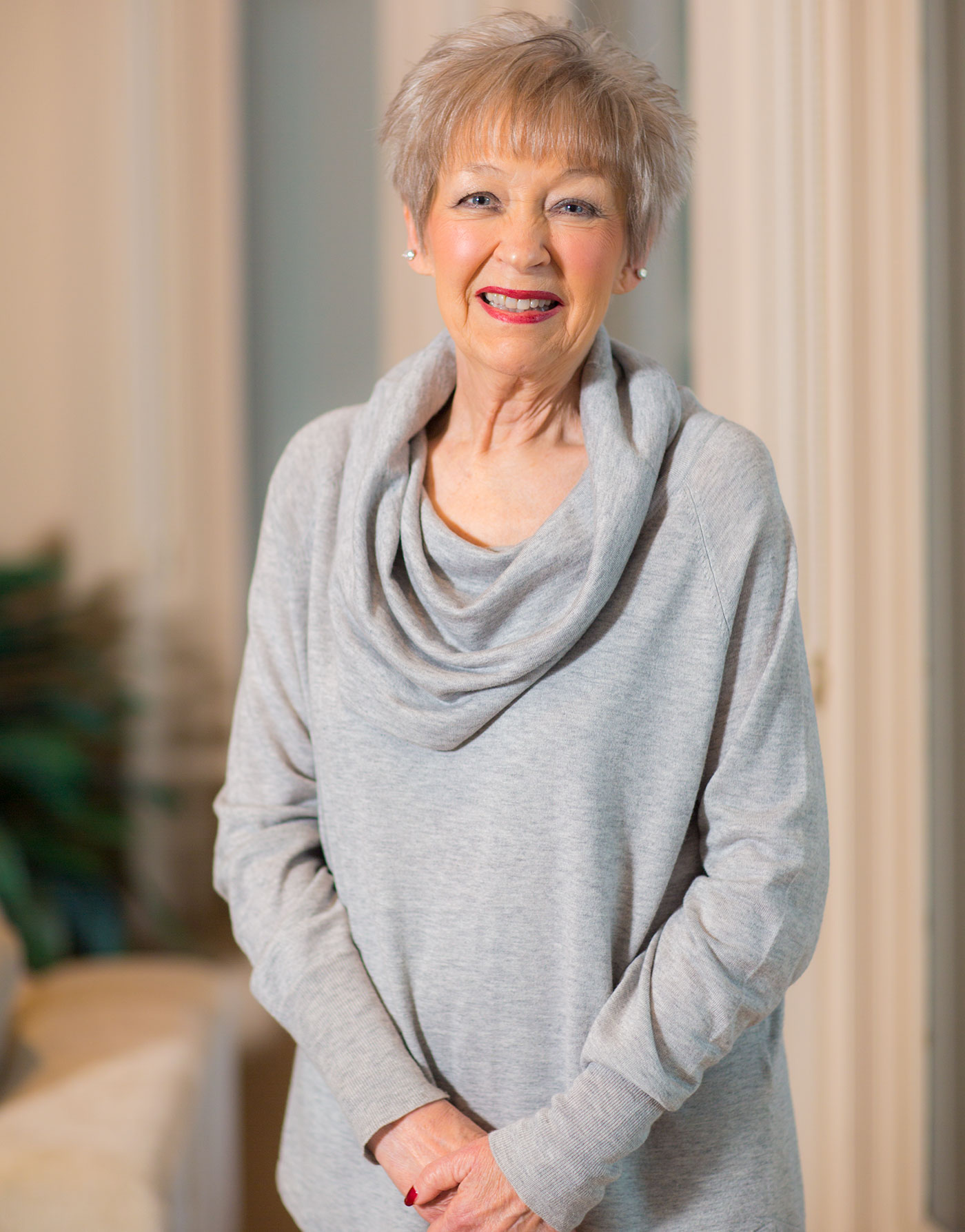
Linda Gordon.
Song inspired Linda Dahl Gordon to enroll at the university in Fairbanks. “I almost went to the University of Washington,” she said. “But when I was in high school I heard the Choir of the North perform. I thought, ‘I want to be a part of that.’”
“If I hadn’t been at school that day, everything would have been different.”
Instead, in 1960 the young woman from Anchorage headed north after graduation to sing under the direction of Ron Berg. Her instincts had been right: The renowned university choir won the Pacific Northwest title her freshman year.

Gordon stopped singing when Berg left the university the next year, but she had already found something else to take its place.
“In gym you had to sign up for two classes,” she said. “I signed up for rifle and skiing. Rifle happened before the snow fell, so I never did learn to ski.”
That’s because even though Gordon had never shot before, she ended up winning the first individual women’s title in the country. She helped make the Nanooks the first team to win the national championship, and helped them win again the next two years. She is clear, though, that the team’s driving force was its coach, Master Sgt. E.F. Horton, for whom the shooting range in the Patty Center is now named.
At the time, the rifle team was part of ROTC, and many on the team were novices, but the master sergeant-cum-coach had the right mix of discipline and motivation.
“Sgt. Horton was just the best,” she said. “If you wanted to shoot at 11 at night, he’d open up the range for you.”
Linda Gordon’s future husband, George Gordon ’62, was also a member of the team. They were one of three couples who went from teammates to spouses.
“We never would have met otherwise,” she recalled. “He was three years older, studying electrical engineering, didn’t take the same classes.”
George Gordon got his degree in 1962, Linda Gordon graduated with a degree in education in 1965, and they became successful business owners and developers in Fairbanks. Shortly before George Gordon’s death in 2014, the pair endowed a scholarship for the Nanook rifle team, a little twist of fate since she had once declined a rifle scholarship offered to her.
She remembers during her college years “being broke all the time, but all of us were in the same boat.”
“Dean [Edward] Voldseth gave me a scholarship, but I turned it down because I didn’t think I was poor enough,” she said.
UAF was smaller then (and less bureaucratic, she noted) but still rich in opportunities.
“My fondest memories are the opportunities given to me by the university,” she said. “Being secretary of the student body, beating the choir at the University of Washington, the rifle team — I couldn’t have done that at Washington.”
“I was lucky to have such great people. It makes you who you are today, puts you in a good situation when you get out of college. You don’t give up.”
— Tori Tragis
Alan Straub ’66
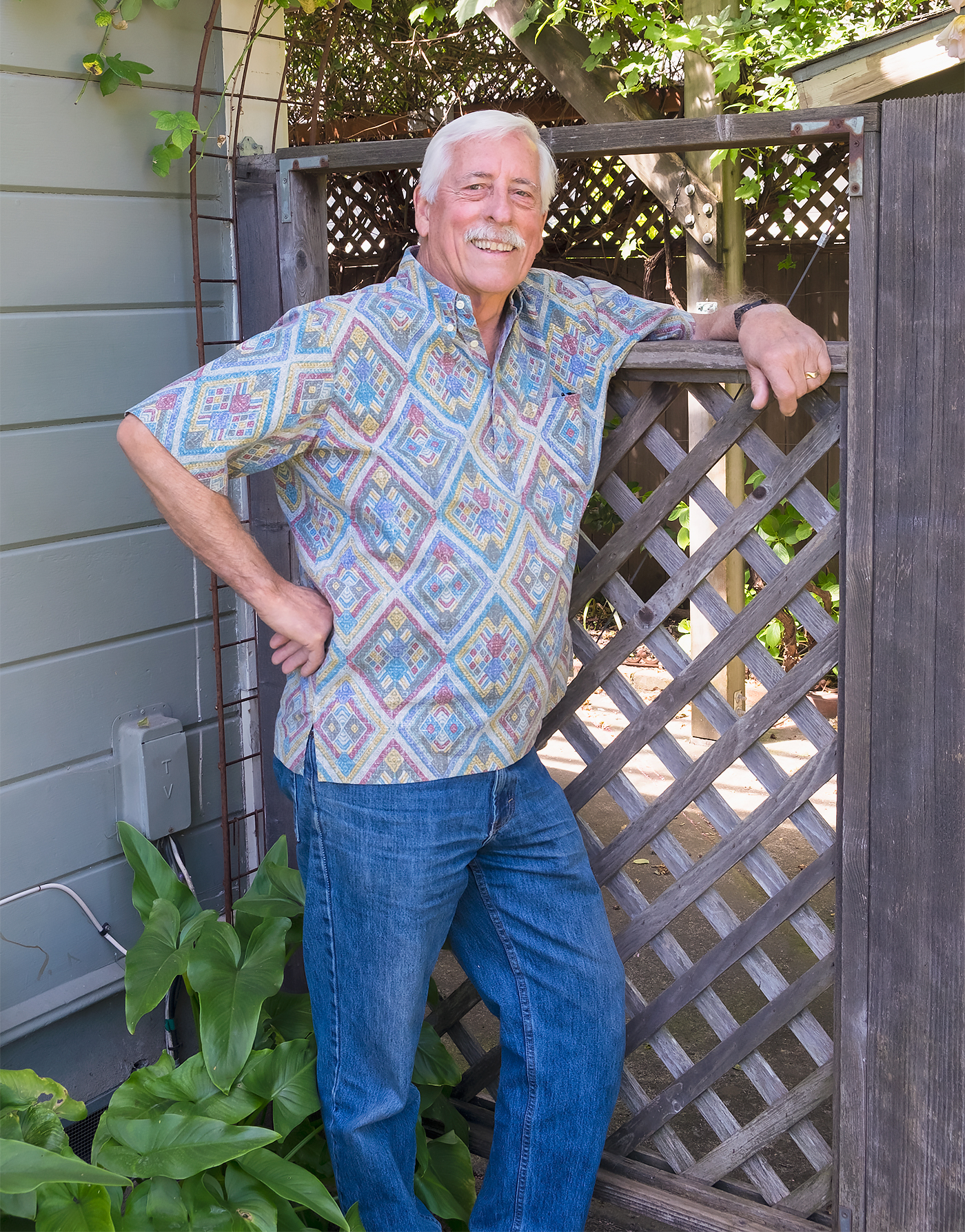
Alan Straub.
When Alan Straub arrived in Alaska soon after statehood, he was a freshly married young man with a new job as an auto mechanic.
Straub and his wife, Linda, had bought a station wagon and left their California hometown in search of adventure. But as they drove through Fairbanks, Straub realized he didn’t have much of a plan for his new life in the remote outpost.
“I didn’t really have a clue what I was going to do,” he said with a chuckle.
The answer came when they passed the University of Alaska. A lifelong tinkerer, Straub figured he could make good use of his time in the North by studying engineering.
It was a good decision. Decades after his 1966 graduation from UA, Straub’s imprint is on bridges and buildings across the U.S. His projects include Aloha Stadium in Honolulu, the tanker docks in Valdez and the Auburn Bridge in California, which towers 731 feet above the American River.
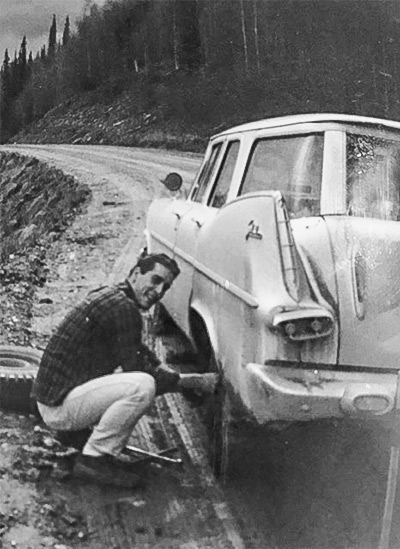
Straub changes a tire near Circle Hot Springs in 1966, a task he recommends everyone learn to do before it’s needed.
“Engineering just felt right to me,” he said.
Straub had always been happy to build things. When he was 12 years old, he put together a ’37 Chevy engine on his family farm in Northern California. He’d eventually become a journeyman mechanic in a local car shop, a job he enjoyed despite the feeling that it wouldn’t provide much of a future.
He was only partly right. It led to the offer to fix cars in Alaska, where his career in engineering took shape and he found new outlets for his urge to build.
The most visible example came during Straub’s senior year, when he planned the construction of a massive three-legged ice arch in the middle of campus. The structure, which he and fellow engineering student Mark Fryer ’66, ’67 built by packing snow into forms and soaking it with water, was 40 feet across, 15 feet high, and powerful enough that someone could use a swing suspended from the center of it. Straub said they recruited Miss Alaska, Carla Sullivan, to give the first demonstration.
That kind of effort caught the attention of faculty, who named Straub the top engineering student during his senior year.
“I about fell out of my chair — it just flabbergasted me,” he said. “There were guys a lot smarter than me, but I was a hands-on kind of guy.”
That quality helped steer Straub toward a varied engineering career. He worked on teams that built bridges in Interior Alaska, jails on the East Coast, and steel bridges and structures along the West Coast. In 1980 he became an owner of Christie Constructors, joining two former co-workers as partners in the Richmond, California, company. He even dabbled in auto racing, setting a class record with his Porsche GT3 at a local road race track.
Straub, 77, remarried after connecting with a high school classmate in the 1990s. He and his wife, Rosemary, spend much of their retirement hauling a fifth-wheel RV touring the U.S. They’ve made it to all 50 capitals and to 13 presidential libraries since 2010, and the RV has been to every state except Arkansas and Hawaii.
A particularly memorable visit was to Alaska, when the couple stopped at the campus where Alan studied as a young man. The friendly reception they received in Fairbanks made an impression on Rosemary, mirroring the feeling Straub experienced more than a half-century earlier.
“She picked up the warmth from the people there, and that’s always the feeling I got from the University of Alaska,” he said. “I’ve got a great love for that place.”
— Jeff Richardson
Robert Bundtzen ’71
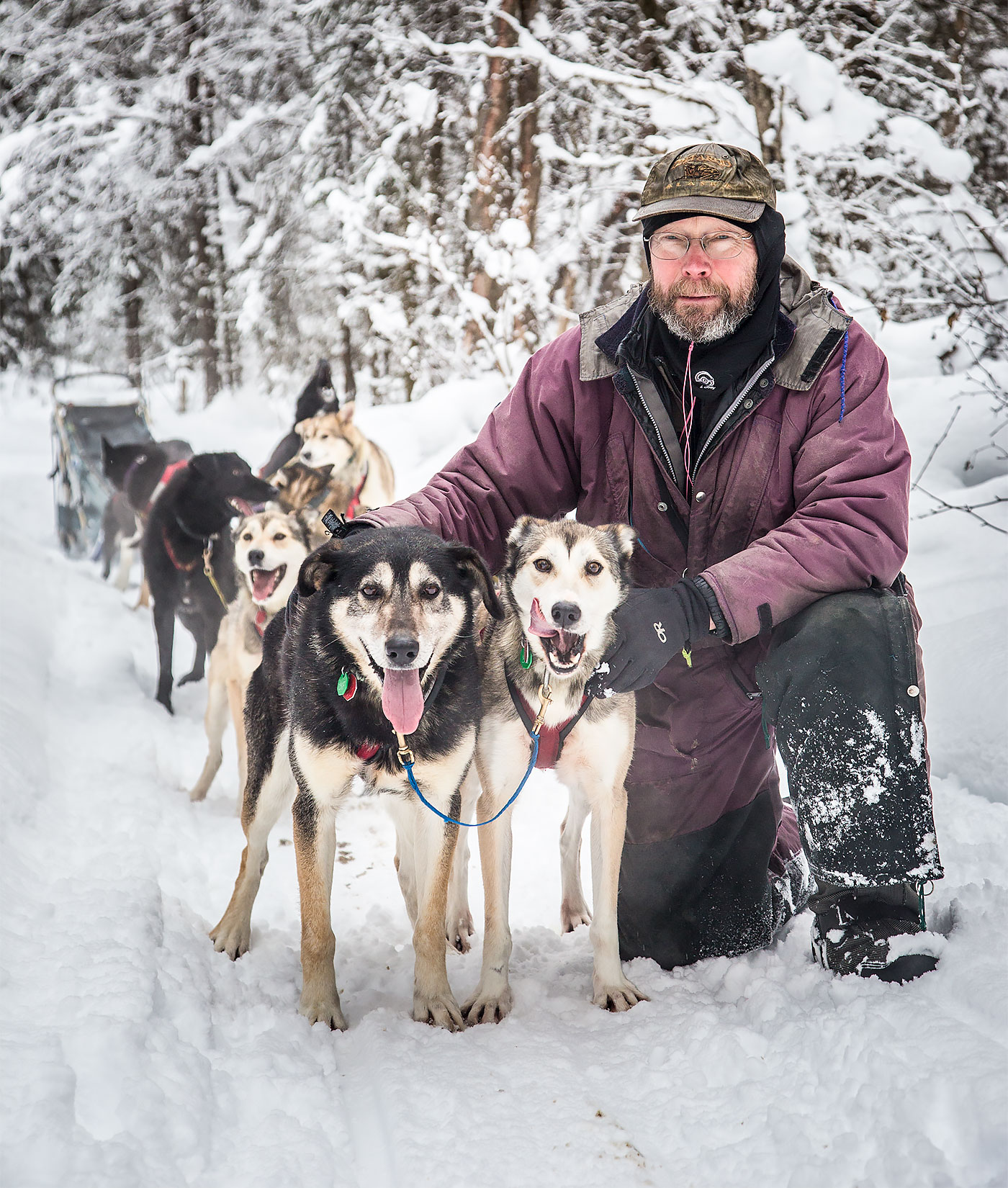
Robert Bundtzen
Spend any time talking with Robert Bundtzen and you’ll hear the word “home” a lot. “Home” means Alaska. Sometimes it refers specifically to Fairbanks, or it could be Anderson or maybe Anchorage, but there’s never any doubt that home is Alaska, for him and for his three siblings, for most of their lives.
Bob Bundtzen’s brother, Tom ’73, ’81, is a Fairbanks-based geologist [see “A Mine for Learning”]. Sister Cheryl Bundtzen-Bradley ’87 is an accountant in North Pole. A second sister, Susan McCloughry, was a nurse in Fairbanks until her death in 2000.
Bob Bundtzen was born in North Dakota and first moved to Alaska when he was 11, in 1960, where he attended University Park Elementary in Fairbanks. He spent the next three years in a one-room school in Anderson while his father worked as an electrical engineer at the Ballistic Missile Early Warning System station in Clear, which was being built at the time.
“Art Anderson sold some of his land and people moved up there and lived in trailer houses,” Bundtzen said. “That’s what we lived in — a trailer house.
“We had a one-room school. Twelve students, four of them Bundtzens.”
The family moved Outside when his mother was diagnosed with cancer, but after she died, they returned to Fairbanks.
“I had already been accepted to the University of Colorado, but I wanted to stay home,” Bundtzen said. “I asked [UAF] if it was still possible to enroll. They said sure, so I said goodbye to the University of Colorado. I wanted to stay in Alaska.”
“I had some great teachers, especially Dr. [Gerard] Swartz,” Bundtzen recalled. “He taught some great courses in biology and parasitology. And there was lots of skiing, lots of going out into the wilderness, although I will say we worked pretty hard as premed students. We had to keep up the grades so we could get into medical school. Early on I decided I wanted to be a physician, and I worked towards that.”

Bundtzen got his bachelor of science degree in 1971, then went to the University of Washington as part of the first cohort of the WWAMI (Washington, Wyoming, Alaska, Montana and Idaho) Medical Education Program for medical students from the Northwest. He met his wife, who was training in pathology, during a fellowship in Madison, Wisconsin. After their education was done, it was inevitable: “We came back home.”
This time home meant Anchorage, where Bundtzen has a private practice as an infectious disease consultant.
“Physicians call me when they have a more difficult case that they feel they want more information,” he said. “Sometimes it’s diagnosis, sometimes treatment. Pneumonia, HIV, AIDS, immunocompromised patients, stuff like that.”
He also works with Anchorage-area hospitals on infection control issues and measures.
Though he now spends his days in a hospital setting, those early years in Anderson (“in the middle of the taiga”) taught him about the outdoors.
“We did lots of trapping during the winter, hunting, fishing,” he said. “I did run dogs but really didn’t know that much. Just used three dogs to pull our gear when we’d go trapping. But it did kind of make me want to do more in regards to dog mushing.”
And how. Bundtzen has run the Iditarod 15 times.
“I scratched twice at Shaktoolik,” he said. “I had leaders that were mentally tired, but I’ve finished every other time.”
Bundtzen’s dog team, currently at 27 dogs, lives in his front yard, part of several acres in the Stuckagain Heights neighborhood in Anchorage. He runs them on the Chugiak dog trails about 30 miles away or trucks them wherever the snow is good. Buntzen most recently helped a fellow Anchorage physician train for the 2017 race, but he hasn’t completely ruled out another trip of his own to Nome.
His schedule will be getting a little more crowded, though — his two young grandchildren have moved from Hawaii to Anchorage, where their father, an IT professional, now works. It’s a family tradition, where all paths lead back home to Alaska.
— Tori Tragis
Terese Kaptur ’76, ’86

Terese Kaptur.
Like the gold miner in the Robert Service poem, Terese Kaptur came to Alaska for a good reason: to get rich. But although she didn’t get rich, she fell under the same spell as the miner, even after she went back home to Michigan.
“I couldn’t get Alaska out of my system,” Kaptur remembered. “I thought about it all the time.”
Kaptur first went to Alaska in summer 1970. Her boyfriend had fought wildfires there the previous year and said it was a financial bonanza. Kaptur wanted a shot at it, and even though 1970 was a dud for conflagrations, she returned for another stint in 1971. That was a better year fire-wise, which was good because Kaptur needed the money: She had enrolled at UAF for the fall semester.
Kaptur had always been good at music and math. But it wasn’t until she auditioned for Professor Jean-Paul Billaud that she truly focused on music, which has been the sustaining force in her life ever since.
Earning a music degree in piano and composition was demanding.
“It was basically a double major,” she said.
She also worked as the department’s music librarian.
The library was a room filled with sheets of music scattered all over, scores and genres intermingled with one another.
The faculty there inspired us and believed in us to achieve our potential and reach beyond it. They were ambitious for us. … They raised the bar really high for us.”
“It took two semesters to sort that out,” she said. “But I learned a lot about that library!”
The Music Department was small, something that was part of her attraction to UAF and that stood in contrast to the large, competitive University of Michigan, which she also considered.
“[UAF is] more intimate,” she said. “The compositions I wrote — my classmates played them, faculty played them. I’d never have had that opportunity or been able to play principal position at the University of Michigan, and that’s still true today.”
Kaptur also began writing grants for herself and other students. It was a skill she would later employ as director of several nonprofit arts associations throughout the country, including the Fairbanks Summer Arts Festival. She uses that venue to fulfill her deepest belief: that in addition to bringing joy and inspiration, music can heal.
One such healing program is with renowned harmonica player Mike Stevens. In cooperation with the Fairbanks festival, he has traveled to various Alaska villages several times to work with young people to encourage musicianship as an alternative to other, destructive life choices they might make. [See related story in the spring 2014 Aurora PDF.]
Kaptur practices what she preaches. After she was diagnosed with cancer in the late 1990s, she underwent a number of operations. Her reaction to anesthesia was debilitating — worse, she said, than the surgery itself. After much research, she found a way to effectively anesthetize herself through music based on her own, highly personalized compositions. It was, no doubt, an outcome of her college education that she could never have anticipated in 1971.
But the outlines of that approach were there even then.
“The biggest gift from being part of the UAF community was the sense of nurturing,” Kaptur said.
“The faculty there inspired us and believed in us to achieve our potential and reach beyond it. They were ambitious for us. … They raised the bar really high for us.”
— Tori Tragis
1980s-2010s
Dolly Garza ’80
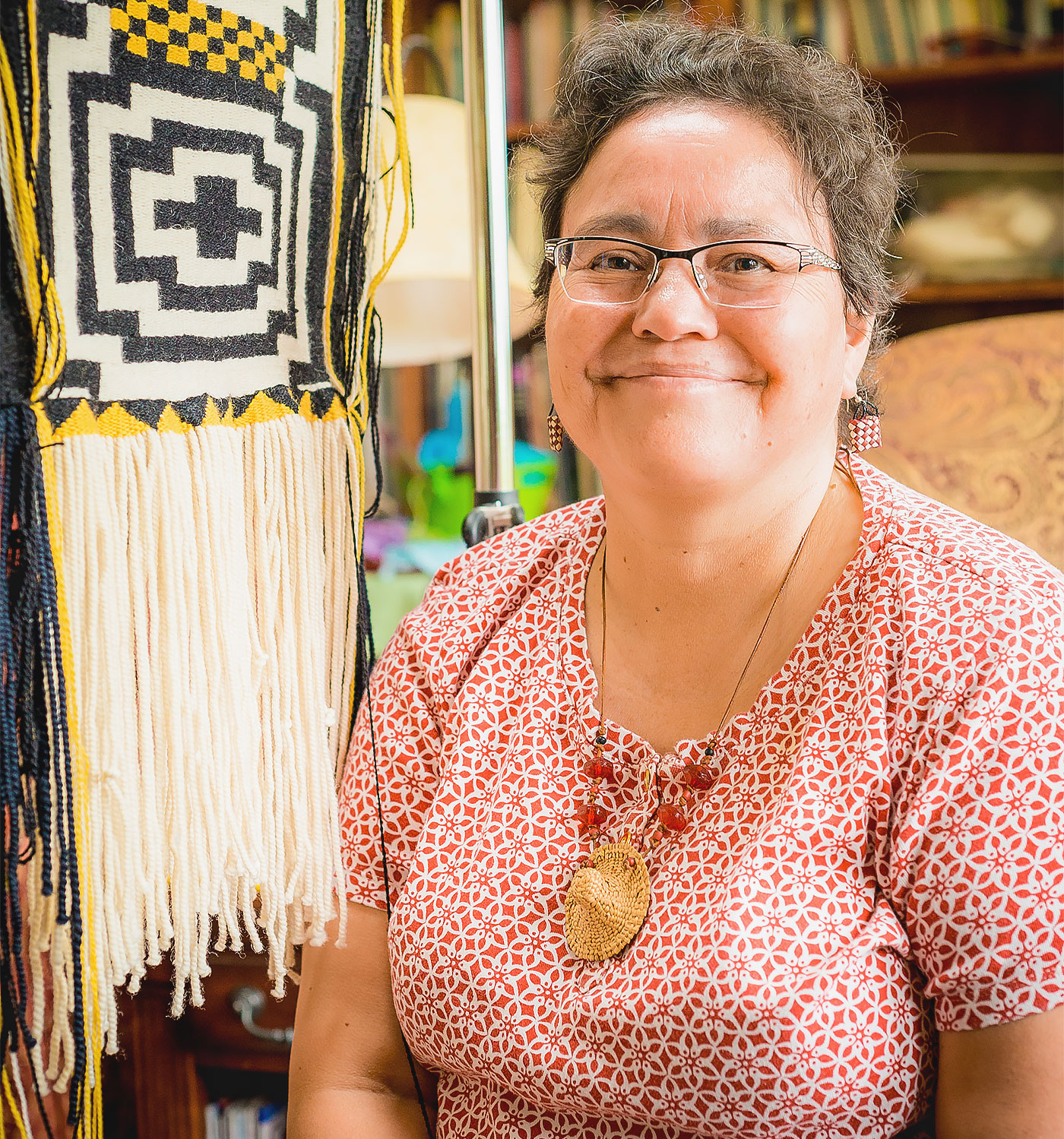
Dolly Garza.
Like many new college students, Dolly Garza arrived in Fairbanks in fall 1975 with only the faintest outline of a career plan.
Garza didn’t head to college with a major or even a sense of what she wanted to study. The Ketchikan High School graduate enrolled at UAF mainly because of a family connection — her uncle, Dennis Demmert, was head of the Alaska Native studies program.
Garza spent her first year taking economics classes before deciding that the home economics program was more to her liking. But that degree program was eliminated the next year, leaving her looking for a Plan C.
“I was in a quandary of what do with my life,” she said.
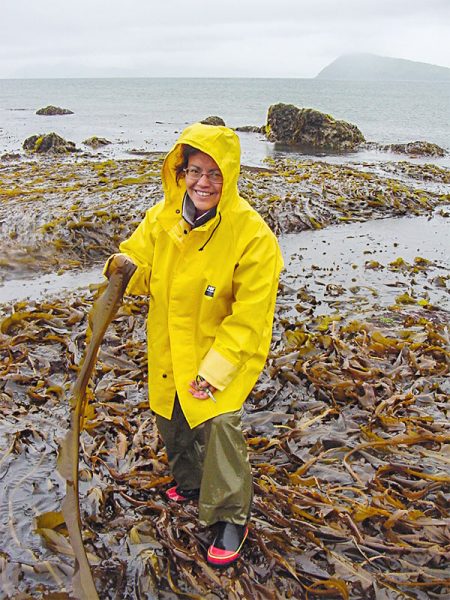
Dolly Garza picks Alaria seaweed during a trip to Kodiak in 2005.
Garza, who grew up in a Haida family, found the answer in a familiar place. Many of her relatives were fishermen, and with their encouragement she enrolled in the UAF fisheries biology program.
It’s a decision that shaped her next four decades, which included three fisheries degrees and a long career as a Marine Advisory Program agent with Alaska Sea Grant. Garza retired in 2006 as a professor emeritus of fisheries. It’s quite a legacy for someone who entered the profession with a decidedly laid-back view of her career goals.
“I had the dream of sitting in one of those towers, counting sockeye as they go by in the rivers,” she said with a laugh.
Garza said Demmert helped her aim a bit higher, and that Rural Student Services in particular helped ease her transition to college. She laughingly recalled her freshman papers “looked like they were bleeding to death” after going through a red-ink edit from a patient English professor who helped her polish her writing skills.
By the time she graduated in 1980, Fairbanks was a second home.
“When I got there, I cried because there was no ocean,” she said. “When I left I cried because I was going to miss it.”
After receiving her bachelor’s degree in fisheries science at UAF, Garza attended the University of Washington for graduate school. Toward the end of her studies, she saw a bulletin board ad for a Marine Advisory Program agent in Kotzebue and landed the job. After a few years, she took the same job at a new MAP office in Sitka, eventually wrapping up her career in her hometown of Ketchikan. Along the way, she took a sabbatical to acquire a doctorate in marine policy from the University of Delaware.
Her work largely focused on helping local fishermen and rural residents understand the vast array of laws and regulations impacting their lives.
Garza also became a noted author and expert on coastal food sources. Her book “Common Edible Seaweeds of the Gulf of Alaska” has been a resource on the subject since it was published by Alaska Sea Grant in 2005. She continues to teach seaweed workshops, offering education about the abundant but underutilized food source in Southeast Alaska and British Columbia.
“It is a passion,” she said. “It’s such a beautiful, healthy food, and we just ignore it.”
Today Garza lives in British Columbia on the island of Haida Gwaii, where her husband, Russ Jones, is leading an effort to implement an islandwide coastal plan. She focuses much of her time on weaving and sewing Haida regalia.
— Jeff Richardson
Charles Stevenson ’85, ’88, ’89, ’95
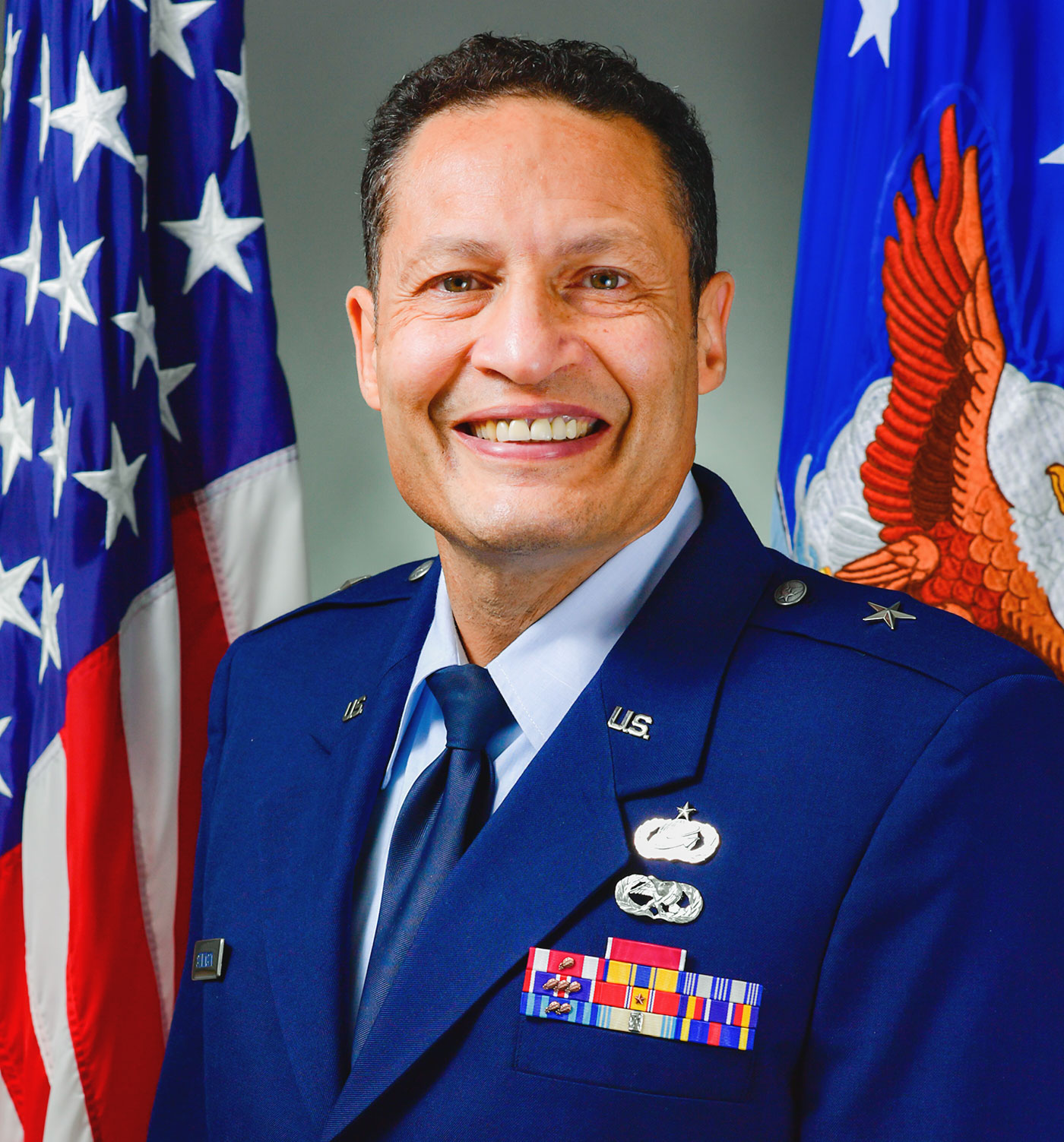
Charles Stevenson.
Charles Stevenson remembers waking up because someone was “moving my face.” It was the professor in his economics class. While taking an exam, Stevenson’s head had dropped to the desk, and it didn’t stir until the class period was done.
“Professor [Bill] Workman was trying to pull the exam from under my face,” Stevenson recalled. “I was out cold, drooling.”
Stevenson was a very busy man during his five years at UAF in the early 1980s. He worked several jobs. He took a full load of classes. He played intramural sports and served as a student senator. He DJ’d dances. Sleep wasn’t on his agenda until it forced its way there.
His pace hasn’t slowed much since.
After a career in which Stevenson rose to superintendent of the state jail in Fairbanks, he moved to Anchorage to become vice commander of the Alaska Air National Guard’s 176th Wing. That led to a move to the Pentagon in Washington, D.C., which brought him his latest assignment: deputy commander of Joint Task Force Guantanamo.
Yes, that Guantanamo, the U.S. Navy base in Cuba where detainees from the war on terror are held. Stevenson, now an Air Force brigadier general, was sent there in late 2016 to be second in command.

Charles Stevenson, left, takes to the floor in the Hess Rec Center during a dance he helped DJ as “Grandmaster Dr. C” in 1984.
Stevenson, in a phone interview in December 2016, said he couldn’t talk about the detainee operations. But he acknowledged that he had never envisioned such a place in his career path.
“Who would think an Alaska guy would be involved in something like this?” he said.
Stevenson arrived in Alaska with his mother just before entering third grade in Anchorage. By sixth grade, they were in Fairbanks. His mom worked as a cook in trans-Alaska pipeline construction camps, at Fort Wainwright and finally at Clear Air Force Station.
After graduating from Monroe High School in 1979, he started at UAF in accounting with a 12-credit load. Finding himself bored, he got a security job on campus.
While Stevenson was on duty one day, he said, justice Professor Gary Copus asked him if he wanted to take classes and get paid for it.
“I said, ‘What are you talking about?’” Stevenson recalled. “He said, ‘We have an intern program for justice majors.’”
So Stevenson switched majors and got an internship at the Fairbanks Correctional Center. He started June 1, 1980, became a full-time employee a year later and didn’t leave until he retired with 20 years of service.
After graduating in 1985 with his justice degree, Stevenson earned two more at UAF in physical education by 1989. Inspired by the training, he arranged basketball tournaments between city league and jail teams. Prisoners got their trophies and videos when they left jail. Stevenson recently saw an ex-inmate in Anchorage who thanked him for the effort, saying, “Those were good times.”
In 1994, Stevenson married his wife, the former Kristine Pomeroy ’94, who also grew up in Fairbanks. They have three children.
Stevenson kept studying. He got a bachelor’s in business at UAF in 1995 and, after retiring from the jail in 2001, earned a degree from Southwestern Law School in Los Angeles. But when the state needed a new jail superintendent, he applied, got the job and returned to the facility on Wilbur Street. In 2004, he had the dubious privilege of being in charge the night someone tried to break into the jail with a front-end loader.
Meanwhile, Stevenson had been working his way up in the Alaska National Guard’s 168th Air Refueling Wing at Eielson Air Force Base. So, after leaving the jail superintendent job in 2012, he took the 176th Wing vice commander position in Anchorage. Three years later, he and his family were off to Washington, D.C.
“The Lord was good and opened doors, or I pushed through them,” Stevenson said of his still-evolving path.
— Sam Bishop
Karen Gaborik ’91

Karen Gaborik.
As the school district superintendent in Fairbanks, of course Karen Gaborik believes in education, taking the scholarly approach, all of that. You’d expect studiousness in someone who was the student commencement speaker. She’s certainly no academic slouch: bachelor’s in speech communication from UAF, teaching certificate and master’s degree in special education from the University of Alaska Anchorage, topped off with a Ph.D. in education administration from Argosy University.
But in her senior year when she was asked in spring 1991 to speak on behalf of her graduating class?
“I was floored,” Gaborik said, smiling wryly. “Because my first two years — I had a lot of fun.”
All that fun had put her well into the center of campus life.
“I think I was selected as speaker because I was so engaged in the student community,” she said.
Gaborik’s first home was Lathrop Hall. She later became a resident assistant in Wickersham.
“It wasn’t my first choice, but I loved it,” she said.
“I have great memories of dorm life. I’m so glad I lived on campus.”
I have great memories of dorm life. I’m so glad I lived on campus.”
Being an RA led her to the student ambassador program, through which she visited area high schools to promote UAF. In that role she was able to practice public speaking, which was part of her major.
“Marsha Stratton’s public speaking class really inspired me,” she said. “I took as many classes as I could from the speech department. Public speaking — performance — was something I enjoyed.”
Public speaking is a regular part of her job as school district superintendent, and education is something of a birthright. Gaborik comes from a long line of educators, including a grandmother who was the first female dean at the Oregon Institute of Technology. Gaborik’s mother went to Alaska to teach, first in Anchorage, then in Fairbanks. Her father, a Vietnam vet, made his way to Fairbanks courtesy of the military. (The pair met at the Malemute Saloon, in nearby Ester.)
After Gaborik earned her communication degree at UAF, her father encouraged her to get her teaching certificate as a backup. She wasn’t sure she would like it, but those first classes in the Teach for Alaska program at UAA convinced her otherwise.
Gaborik grew up in Salcha, a small community near Fairbanks. She graduated from Eielson High School, where she would later return to teach. UAF was, she said, a natural choice. She was an avid cross-country skier, and she hoped to continue that as a Nanook.
But then she took a rifle class with coach Randy Pitney on a whim, and her focus shifted.
“I redshirted the first year, but I made a good run after that,” she said. “Made All-American.”
Gaborik spent many long hours practicing with the rifle team, an activity that required a mix of camaraderie and independence.
“It’s a reflective, disciplined sport,” she said. “It appealed to my introspective side.”
Ultimately, though, friends and professors loom largest in Gaborik’s mind.
“Most of my memories are around people,” she said. “When I think of UAF I think of them.”
— Tori Tragis
Sven Haakanson ’92
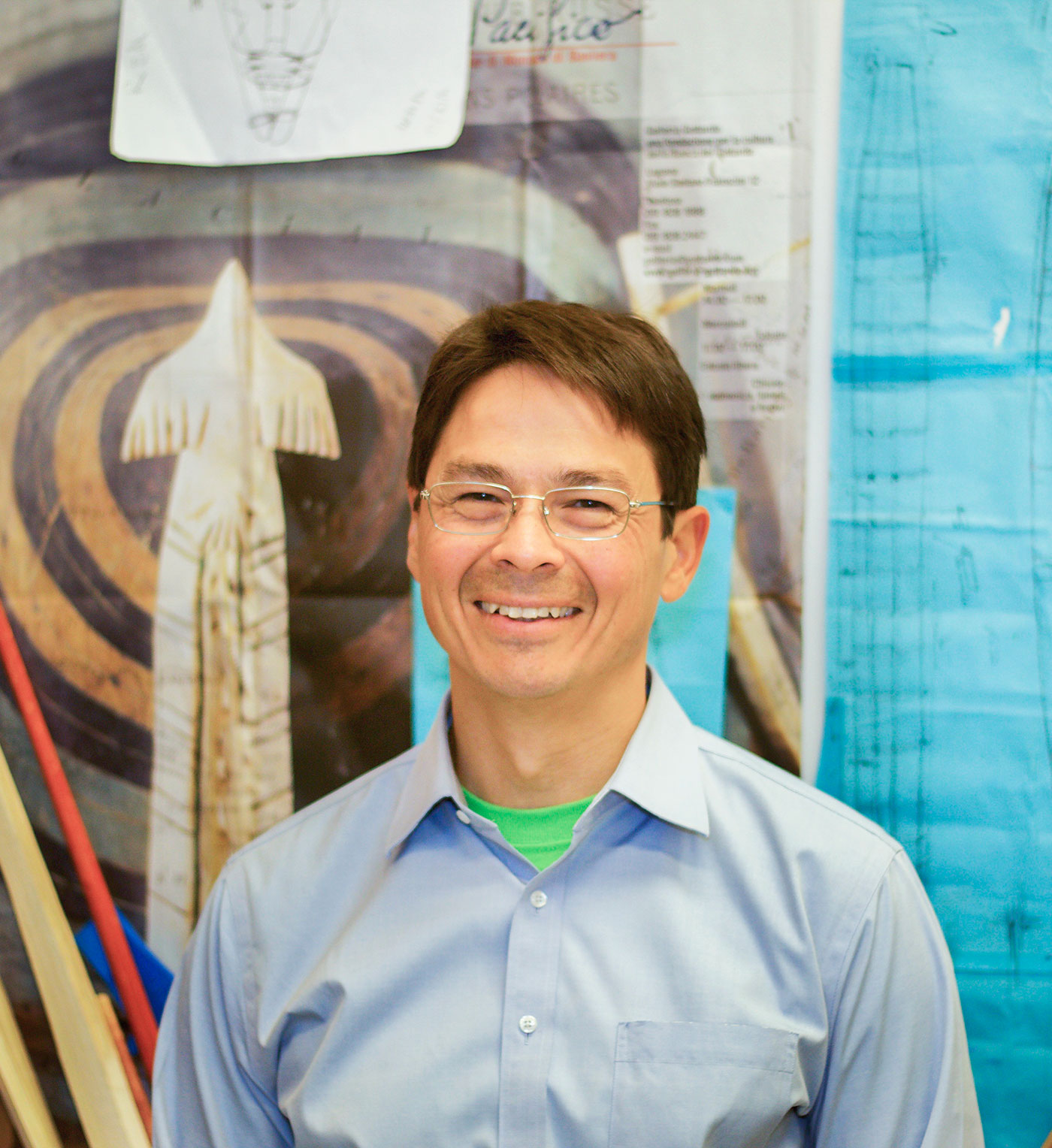
Sven Haakanson.
Sven Haakanson is like a lot of UAF students, to a point. He’s from Alaska — Old Harbor, on Kodiak Island — and he enrolled because it was affordable, although he expected to have to work his way through college.
Despite having spent his last year and a half of high school in Anchorage, Haakanson worried that life in a small village had left him unprepared for university.
“I didn’t know if I’d be able to graduate,” he said.
Rural Student Services was his safety net. Going from a place where he knew everyone to a place where he didn’t know the person sitting next to him was a challenge, he said.
“They helped me adjust. I was the first in my family to go to undergraduate school and graduate.”
The original plan was to get an English degree and a teaching certificate, then teach in the winter and fish in the summer. But he took some classes in anthropology and caught the notice of his professors, who arranged for Haakanson to fly to Denmark for a conference where UAF anthropology Professor Lydia Black was to deliver a lecture. That changed everything.
“Dr. Black was amazing. I was sitting there, on the other side of the world, listening to her talk and learning about my own people,” he said, referring to his Alutiiq ancestry, “and wondering why I hadn’t learned all that at home.”
Dr. Black was amazing. I was sitting there, on the other side of the world, listening to her talk and learning about my own people,” he said, referring to his Alutiiq ancestry, “and wondering why I hadn’t learned all that at home.”
He tried to carry two majors once he got back to UAF, but combined with getting a teaching certificate, it was too much. The certificate alone was a full-time job, one he undertook in Magadan, Russia, which, in 1991, was just beginning to open up to Westerners.
“That experience in itself was very formative for the things I’ve done since,” Haakanson said. “It allowed me to learn Russian, speak it fluently, and have an experience very few Americans have the opportunity to do. Up until then we propagandized how the Soviets and Communists were this and that, and I got there and saw the people were just trying to live and survive, like us.”
It also gave him a lot of alone time.
“There was a group of us that started off in September, and by December there were two of us left, and in January I was left by myself for the last six months.”
That total immersion helped him undertake his dissertation research on the Nenets people of Siberia. After graduating from UAF in 1992 with a degree in English and that teaching certificate, he was offered a scholarship to do his Ph.D. at Harvard. He went on to direct the Alutiiq Museum in Kodiak, and he won a MacArthur Fellow “genius grant” in 2007. He now teaches anthropology at the University of Washington and is a curator at the Burke Museum.
Haakanson maintains his strong ties to Alaska. He serves on the board of directors for Koniag Inc., consults for the Rasmuson Foundation and attends the annual Alaska Federation of Natives conference, among other things. He is very clear about his early inspirations.
“I got to know Lydia Black and Perry Gilmore and David Smith,” he said, recalling his anthropology and education teachers. “UAF — you have so many wonderful professors. I struggled with not having good writing, but they challenged me to go beyond my comfort zone. That was the kind of thing I loved about UAF.”
He paused, getting ready for another story from his student years.
“I applied for my passport [to go to Denmark],” he said. “It was coming in on a Friday and I was supposed to leave that Saturday. The campus post office closed at 5, but they stayed open another hour so I could get there. That’s the kind of thing that shows how wonderful UAF and people in Fairbanks were.”
— Tori Tragis
Reija Shnoro ’06

Reija Shnoro.
Reija Shnoro knows it’s a cliche, but the story is true: When she was a child growing up in Finland, she saw a documentary about Alaska, and she knew that’s where she had to be.
“It showed the wilderness, the animals,” she recalled. “I think it was called ‘This Is Alaska Wild!’ I still remember sitting on the floor, too close to the TV, and I thought — ‘Alaska? OK, I’m totally going there one day.’”
It wasn’t that life in the rural North was exotic to Shnoro. The small village she grew up in, Mieslahti, sits some 350 miles northeast of Helsinki in central Finland, at about the same latitude as Delta Junction, Alaska, but with a third of its population. Still, there was that pull. So when she decided to study abroad during law school at the University of Lapland, she looked at Norway, England and Alaska, and knew where she would go.
That was in 1999. She stayed a full year, went home to finish her classes, then came back to UAF in 2002. Returning to Finland, she worked in the legal field for two years before once again enrolling at UAF in 2004, this time to pursue a master’s degree in Northern studies.
“I knew I wanted another degree,” she said. “My choice was either Finland or Alaska. Northern studies seemed like what I wanted to study.”
People [in Finland] are afraid of all the animals — you know, moose running around everywhere.”
While the sub-Arctic wasn’t a complete surprise to Shnoro, one aspect of Interior living did catch her off guard.
“I was surprised it is really way colder,” she said. “It gets cold in Finland, but Fairbanks is definitely colder.”
Shnoro met her husband in Fairbanks, an American archaeologist who moved north to work as a consultant. They recently bought a home (plus “eight chickens that came with the house”).
Even after many years in Alaska, Shnoro still impresses her friends and family in Finland with her adopted home.
“Just the fact I live in Alaska is a big deal,” she said, chuckling. “People [in Finland] are afraid of all the animals — you know, moose running around everywhere.”
When Shnoro isn’t facing down rampaging ungulates, she helps international students navigate the paperwork and immigration compliance to study at UAF. She works with degree-seeking students, from when they first apply for a visa to helping them secure paperwork for postgraduate practicum training.
“I want to see an increase in international students coming this way, and also UAF students using the study-away program in foreign countries to get that experience,” she said. “It’s good for a university to have students from other countries and cultures. It brings a lot to a university.”
It’s a position she is especially well-qualified for, given her training as a lawyer and her own experience as an international student.
“I’ve been in their shoes, so I know,” she said. “If a student needs to talk, I can tell them my experience. They know it’s not only them — the feelings, concerns, excitement, but feeling worried at the same time. Other people have done it, too. They’re not alone.”
— Tori Tragis
Eric Hill ’08
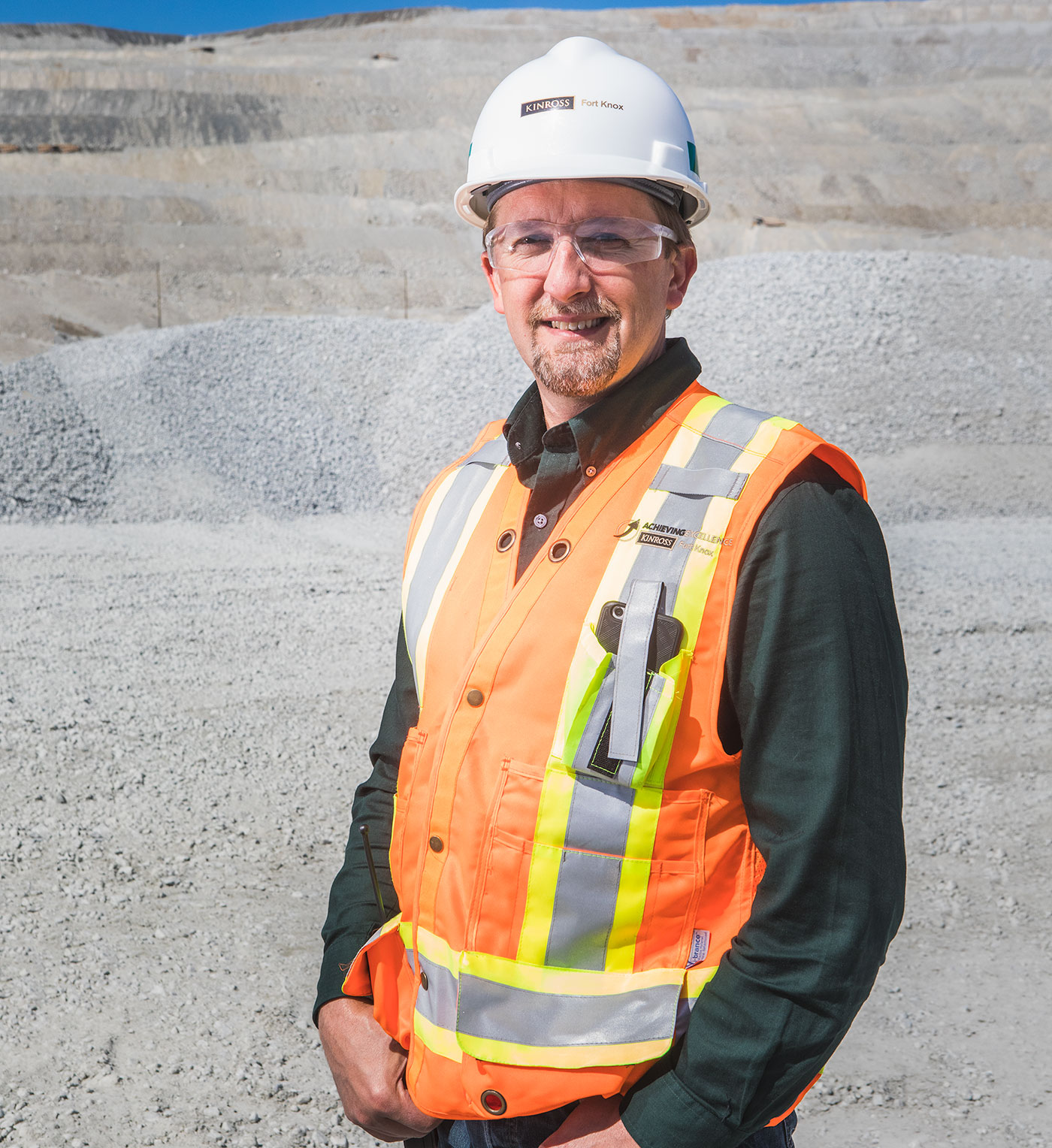
Eric Hill.
Eric Hill found himself out of sync with his fellow students when he began taking classes full time at UAF in 2006. It wasn’t just his age, which was twice that of many fellow undergraduates. It was his work schedule.
“In so many years of mining work, you’re getting up at 3 or 4 in the morning so you can get on the job by 5 or so,” Hill said. “So I’d roll onto campus for classes, and it’s 6:30 or 7. You go to the library or anyplace on campus and it’s dead for the next two hours.”
Hill, who today is general manager of the huge Fort Knox gold mine, started mining in 1988, right after high school. He moved to Fairbanks in 1997 to work at Fort Knox, which had begun producing gold the previous year. The mine, about 15 miles north of Fairbanks, poured its seven-millionth ounce in August 2016.
Throughout his years in the business, Hill took classes on the side, working toward an engineering degree.
“Finally I was like, I’ve got to put this all together before I lose focus,” he said.
So he hit the books full time for four semesters and earned his mining engineering degree in 2008.
He knew such learning could come in handy. A few years earlier, a UAF class had inspired him to invent a solution to a longstanding problem at Fort Knox.
We did the research, did the lab work and ended up creating a patent on the process.”
Fort Knox uses carbon to collect gold molecules from a solution. In the early 2000s, the mine could screen most but not all of that carbon from its final product.
“There’s a bit of that carbon that gets so small that you can’t capture it on screens, and we end up packaging that material up and having to ship it somewhere,” Hill said.
That was inefficient. Working with hydrometallurgy Professor Steve Lin, Hill created a way to transfer gold from small carbon pieces to large ones that then could be screened.
“We did the research, did the lab work and ended up creating a patent on the process,” Hill said. Fort Knox adopted the method for a time, and a technical paper about the process won the Society of Mining, Metallurgy and Exploration’s Arthur Taggart Award in 2003.
Hill grew up in northern Nevada, where his family farms alfalfa. The mining industry boomed just as he graduated from high school.
“There were 14 active mines within the county I lived in,” he recalled, so he hired on with one.
At that time, it was clear he would need an academic degree to get ahead.
“I started community college classes after work, a couple classes at a time,” he said.
The industry eventually became less focused on promoting people with academic degrees, he said, so he advanced well even without one.
“But by that time, I’m so committed and so far down that road,” he said, “it was important to keep growing.”
Hill, who is engaged, has three children from an earlier marriage. The two youngest attend UAF, and his fiancee also has a mathematics degree from the school.
Hill said he appreciates UAF’s approach to students like him who work and have families.
“They were very accommodating … if you couldn’t make it to class,” he said. “I thought that was a testament to the staff up there.”
— Sam Bishop
Pearl Brower ’04, ’10, ’16
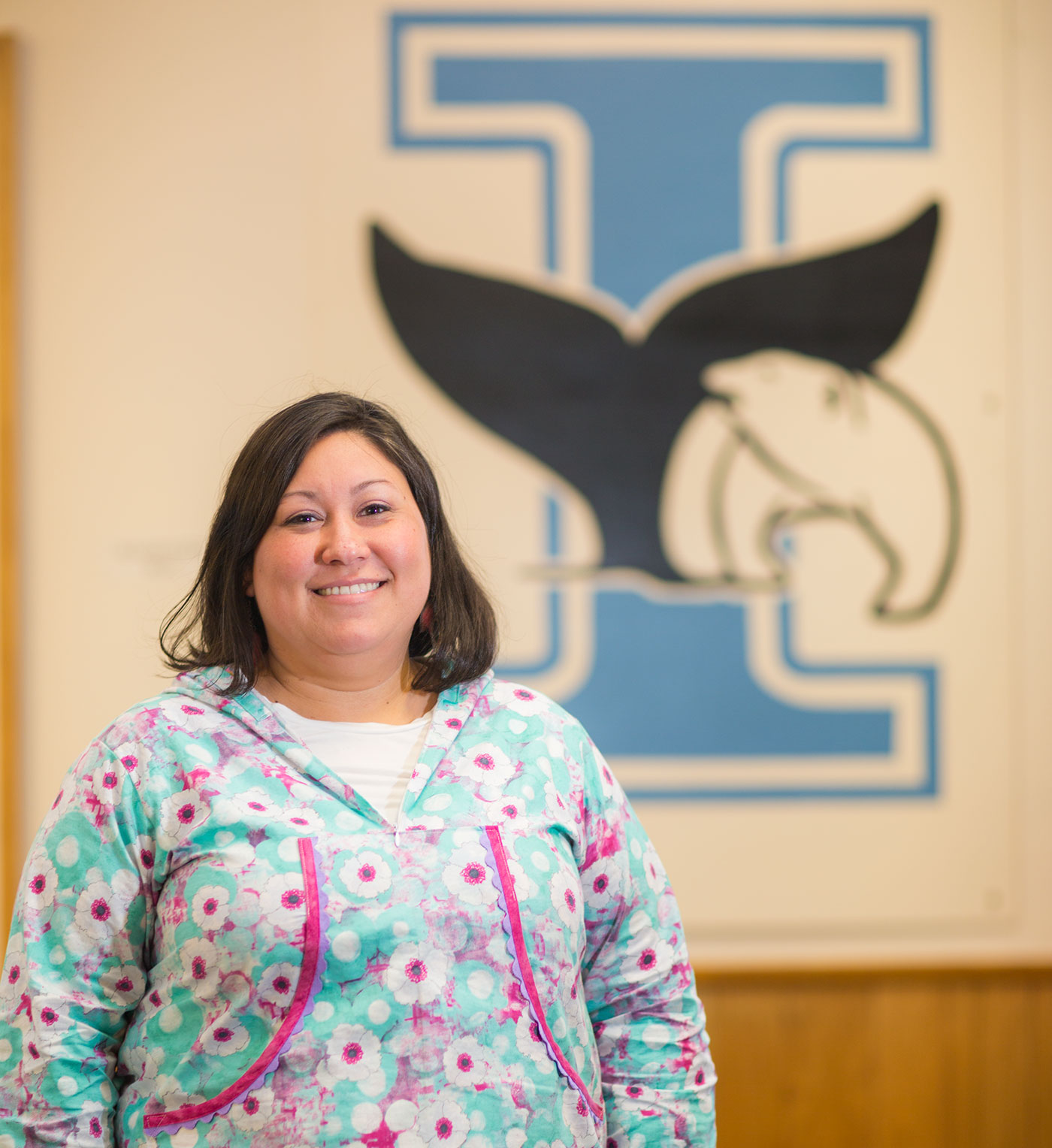
Pearl Brower.
“I loved UAF,” said Pearl Kiyawn Nageak Brower. “I loved the programs I was in and the opportunities I was provided. Lots of various people supported and mentored me. It’s definitely brought me to where I am today.”
Today Brower lives in Utqiaġvik, the new, official name of Barrow. She is the president of Iḷisaġvik College, a position she’s held for five years. (She’s worked there 10 years altogether.) Centered around Iñupiaq culture, Iḷisaġvik is a two-year tribal college that focuses on academic, vocational and technical education.
Brower grew up between the North Slope and a rural community in northern California, where she attended a community college for two years. But she was ready to move back to Alaska. Then two of her best friends told her about the school they were going to in Fairbanks.
Once I got to UAF, my interest in Alaska Native culture really expanded. I realized how amazing and wonderful all our Alaska Native cultures are.”
“My friends convinced me UAF was where I needed to be,” she said.
Brower had been studying anthropology, but she was also inspired by Professor Phyllis Fast, who pushed her to pursue a second degree, in Alaska Native studies.
“She was amazing,” Brower said. “She really nurtured and encouraged me in all the right ways.”
Brower’s academic interests were rooted in her Iñupiaq heritage as well as her fascination with other cultures.
“I value what everybody’s culture brings to the world,” she said. “And I was wanting to be able to communicate truthfully what my culture was and who I was as an Iñupiaq woman. Once I got to UAF, my interest in Alaska Native culture really expanded. I realized how amazing and wonderful all our Alaska Native cultures are.”
Rural Student Services gave Brower a second home and people who remain her friends today. She and some in her group created the Native Student Organization in the late 2000s, complete with a governing board and a slate of activities.
“It was a nice group of peers. That was what was most meaningful to me.”
Brower is enthusiastic in her memories of UAF but remembers challenges as well. Alaska Native people weren’t always well-represented in classes at UAF, so their perspective wasn’t heard. Likewise, she said most institutional programs did not always meet the needs of Alaska Native and rural students. Now in charge of her own school, she focuses on the specific needs of the largely Native population at Iḷisaġvik.
In the last few years, Brower has earned her master’s and doctorate from UAF, all long-distance and all while working full-time. She also has a husband and a young daughter.
Brower was named to the Alaska Journal of Commerce’s Top 40 Under 40 list in 2015, an honor she did not mention in an interview. What she did bring up was being named the undergraduate Alaska Native Studies Student of the Year.
“That was incredibly meaningful, having that kind of recognition,” she said. “It made me realize that Alaska Native studies was something I wanted to do for the rest of my life.”
— Tori Tragis
Colton Parayko ’16

Colton Parayko.
While navigating the most pressure-filled environment of his career, Colton Parayko found an escape in an uncommon place.
Parayko, a defenseman for the NHL’s St. Louis Blues, was capping an outstanding rookie season with a deep run in the Stanley Cup Playoffs. But between games, he filled his time by taking online courses from UAF.
The former Nanooks hockey player left Fairbanks after three years to begin his professional career in 2015, when he was just seven classes shy of a business administration degree. Instead of leaving those lingering requirements for another time, Parayko took distance-ed courses and kept studying during his first year in the NHL.
“It was a good opportunity for me to get away from hockey and do something else,” he said. “When you’re in a new job, especially one like this, it can be a little overwhelming. It gave me something else to think about.”
Juggling hockey and studies didn’t seem to hurt Parayko, who earned a spot on the NHL all-rookie team. He’d grown used to that routine during his time at UAF, which made a three-course schedule during the playoffs seem quite reasonable.
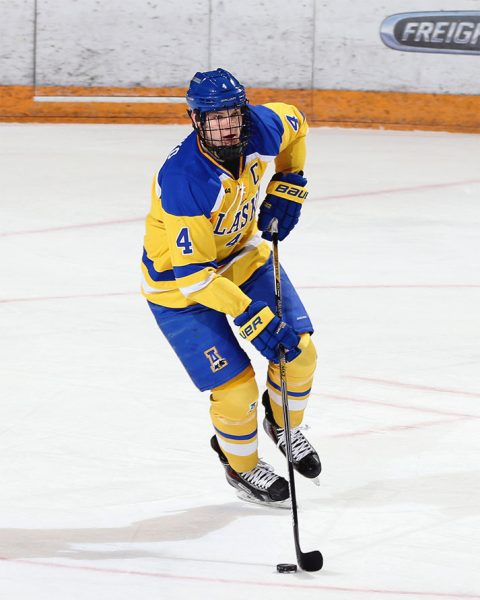
Colton Parayko skates at the Carlson Center in December 2014 during his third and final season with the Alaska Nanooks.
“We took five while we were at school, so it wasn’t so bad,” he said.
Parayko was rewarded with a diploma after wrapping up his final two courses in summer 2016.
Nanooks hockey coach Dallas Ferguson ’00, recently hired as the Calgary Hitmen’s head coach, isn’t surprised by Parayko’s dedication. He said his former player displayed a formidable work ethic during his time in Fairbanks.
“Colton’s workload and willingness to improve in all facets of his life was something that stood out to me while he was a student-athlete at UAF,” Ferguson said. “There was never a practice, game, training session or day that passed where Colton was not pushing himself to be a better version of himself.”
Earning a UAF degree capped an unconventional journey for the native of St. Albert, Alberta.
Parayko was drafted by the Blues in 2012, but decided as a teenager to pursue a college scholarship, unlike many Canadian hockey players who develop their games in the top junior leagues. Parayko was offered a spot with the Nanooks and invited to visit Fairbanks, where he clicked with Ferguson and UAF.
Fairbanks was cold, but just a bit more than his hometown, and it was fairly small, which was also part of its appeal.
“I really liked it,” he said. “The people on campus were really friendly. They kind of opened their arms to you.”
Parayko said he enjoyed both his studies at UAF and his role with the Nanooks, which included three winning seasons, many lasting friendships and strong community support. But when the Blues offered a contract after his junior year, he made the difficult decision to turn pro with a year of college eligibility remaining.
But even after making an NHL roster, Parayko said there wasn’t any doubt he’d continue to pursue his studies at UAF. The accomplished Nanook is already preparing for the next chapter of an impressive story.
“Hockey’s only going to last so long,” he said. “Hopefully I can do something with my degree when I’m done.”
— Jeff Richardson



